Literary Criticism
One sentence micro-reviews of each film, show, book, and game that I watched,
read or played over the last year. Each item recieves a letter grade from F
(terrible) to A (a must watch/read).
Key:
- (B)
- Reserve for items that are so good and re-watchable/readable that they
deserve to bought as a physical addition to my library.
- (R)
- This is a re-read or re-watch of a volume in my library.
- (S)
- A multi-episode show, an ongoing comic, or series of books instead of a single
contained volume.
Films (36) & Shows (10)
- There Will Be Blood - A (B)
- Long biographic exploration of the nature of the oil rush to the west. A deep
exploration on the relationship between religion and money in the American west.
Definitely recommended.
- Legend - C+
- Watched just for the famous “unicorn” scene that many claim was reused in the
dream sequence of Blade Runner. It’s not a particularly smart film, but it
does leave me wishing the genre had taken off more than it has.
- Snowpiercer - B+
- The imagery of Snowpiercer is stunning and lasts with me. A kind of dark Willy
Wonka story and examination of class barriers. Worth a watch.
- Annihilation - C-
- Forgettable. It’s science fiction. It’s a blockbuster.
- The Holy Mountain - A (B)
- Second favorite Alejandro Jodorowsky film after El Topo. Although,
unfortunately decidedly less coherent.
- Jonny Mnemonic - B+
- Based on a William Gibson short story and it does a very good job of capturing
the kind of vibe that I get from reading Gibson.
- 8 1/2 - A (B)
- One of those art house kind of films examining the kind of burn out that a
creative type feels while trying to force something into creation that just
refuses to budge. There’s a lot of characters, scenes, just stuff that spoke so
very much to my life in this film.
- Yojimbo - A (B)(R)
- One of Kirasawa’s more lighthearted period pieces. Yojimbo is a rounin who
comes to town and pits two gangs against each other to their mutual destruction.
- Crooked House - B
- Fun who-dunnit type of film with a decent amount of Brittish humor thrown into
the mix.
- Hackers - B+
- Required watching for the folks over at hackers.town. Watched twice in the
last year. It grows on you. Someone described this to me as a film about what
2600 imagined they were up to in the nineties.
- Invasion of the Body Snatchers - C+
- Watched the original. The inspiration for pod people, lizard people, all the
different wonderful conspiracies that our government is run by people totally
out of touch with humanity.
- Saturn 3 - B
- This was probably a big-budget when it was made, but has a very cheap “B”
quality feel to it today. Nonetheless, the robot is absolutely terrifying.
- Death Race 2000 - B
- Bloody, violent, brilliant. Just dumb but in a constant state of satirizing
American politics.
- Sneakers - A-
- A heist/hacker film. It seems like the early nineties had a host of films
fascinated with hacker-chic. As far as a “hacker” film goes, it’s pretty good
even if villian has a bit of Bond-villian vibe going on.
- Escape from LA - C
- Not as good as the original. It leans too far into attempting to both lampoon
Hollywood and provide a satire of American culture that ultimately makes it fall
flat compared to the original.
- The Quiet Earth - B+
- A post-apocalyptic film out of New Zeland. Don’t mind the “science” as none of
it makes any sense. One of those, someone guy wakes up and finds himself the
last soul on earth, except for a couple others. Great atmosphere.
- Mad Max - B (B)(R)
- The original Mad Max tells a story on the edge between Fallout style
distopia and our present day. The way it captures the dissociation between Max’s
career as a cop seeing the collapse of orderly institutions and his family life
where he tries to maintain a semblence of normalcy is entirely topical for our
era.
- The Road Warrior - B (R)
- The sequel introduces so much of the aesthetic of post-apocalyptic film. As
far as action films go, its violent, exciting, a thrill to watch but misses the
social commentary of the first film.
- Shazam - C-
- Dumb fun. Watched in the single-screen theatre, so it was my only option.
Otherwise, not worth it.
- Night is Short, Walk on Girl - A (B)
- Brilliant feature-length tour-de-fource of Masaaki’s creative ability and a
welcome return of many of the side-characters from Tatami Galaxy.
- Once Upon a Time in Hollywood - B
- There is a good twist to this film. It is a great romanticization of Hollywood
and Los Angeles and a time period that is far behind us. A good film to watch
and revisit a time before I was alive.
- Johnny Handsome - B-
- A pulpy kind of noir film with a big dose of revenge thrown into the mix. It
was a fun watch on a hot afternoon when I needed to find a cool theater to sit.
- The Public Eye - B+
- Joe Pesci plays a photo journalist specializing in murder photos who gets in
over his head. A really decent noir from the early nineties that captures much
of the better aspects of the genre.
- Pulp Fiction - B+
- Surprisingly not taken in by this film nearly as much as I expected.
- The African Queen - C+
- Bougart plays an excellent drunk. Not my favorite of his films, but it’s one
that I’ve seen posters and clips from so much that it is worth a watch.
- IT Chapter 2 - D
- Heard great things about Chapter 1. Can’t say the same for Chapter 2.
- A Simple Plan - B
- There’s a big part of me that loves films featuring the northern-midwest,
particularly if they do a good job of capturing the kind of culture you find in
WI and MN. A comedy of errors that build and builds in an increasly tragic way.
- The Vanishing - A- (B)
- Lighthouse double feature! The Vanishing is a fairly similar concept to The
Lighthouse. People go nuts. Then they disappear from the rock.
- The Lighthouse - A (B)
- Watched this in an art-house in Tucson. Great atmosphere and storytelling.
Absolutely terrifying and iconic imagery.
- The Saga of Tanya the Evil: The Movie - B (S)
- Good sequel film to a dumb show that I still can’t believe I watched.
- Princess Mononoke - A (B)(R)
- I discovered Ghibli-fest this year and made the three hour drive to
Albuquerque just to catch my favorite of the Ghibli films.
- Spirited Away - A (B)(R)
- My second-favorite Ghibli film and a wonder to catch on the big screen.
- The Dark Crystal - A-
- Hensen’s films have aged extremely well. The puppetering is something that is
extraordinarily timeless in presentation.
- Ford vs Ferrari - C
- This film takes a subject matter that I know, and care nothing about and makes
it fascinating. It wasa fun watch in the theatre, though not sure if it is worth
putting an effort into watching it.
- Battle of Unato - B
- Unato is a weird sell. It has the tone and feeling of the good half of
Kanebari, but is missing most of the character development and lethality of
the monsters. Yet, it was fun to revisit the setting and characters.
- Hustlers - C+
- A good watch. I would actually call this a heist-film, although one from a
wildly different perspective than anything else in the genre.
- Tokyo Godfathers - A (B)(R)
- Satoshi Kon’s life and career was cut far too short. Making this an annual
Christmas Eve watching.
- Planetes - A (B)(S)
- This is the kind of slow, character driven kind of Anime that seemed to appear
for a very brief period in the early 2000s before disappearing into the hole of
moe.
- Devilman Crybaby - A (B)(S)
- Masaaki at his most violent. The story is a rather hopeless Faustian
experience that simply escalates into the stratosphere. Beautiful animation
throughout.
- Bojack Horseman - A (S)
- Very slow start. It took until half way through the first season to really get
hooked on the show. Then the ride was wild – I could oddly relate to almost the
entire cast. The ending was… tame, should have ended an episode earlier.
- The Expanse - A (S)
- Amazon is throwing a lot of money at this show, and it really shows. The last
season on ScyFy was rather lacking, but this is a return to the intrigue and
games of the earlier seasons.
- Rick & Morty - B (S)
- The episodes themselves are good, but I’m starting to get a feeling that the
show is starting to run out of material. The latest season is also starkly
lacking in any kind of character development for Rick, which has largely been my
interest in the show.
- Tatami Galaxy - A (B)(S)
- Masaaki at his best! An absolute favorite. I had forgotten so much of how this
show plays out. A great examination of personality, of the absurd, and leaves me
wanting to visit Kyoto.
- The Dark Crystal: Age of Resistence - A- (S)
- Still waiting on a second season. Overall, excellent except it ends on a
lighter note leaving a huge gap between the events of the show and film. Yet, it
excellently captures the feeling of Hensen’s work.
Games (3)
- Magic 2014 - C
- Fun distraction for a short time. The limitated number of deck options and
inability to really engage in deck building though severely limited the
replayability of the game.
- Mario Maker 2 - A (B)
- Made some really fun levels with this, and played some really fun levels. If
anything, I became distracted too quickly by…
- The Legend of Zelda: Breathe of the Wild - A (B)
- An epic game that lives up to it’s reputation. A wonderous take on the open
world genre adapted to the sensibilities of Zelda. It does start to get tedious
after a while, particularly if you approach it from a completionist viewpoint.
Literature (12)
- Return to Dominaria by Martha Wells - F
- Tried to give reading the Magic lore a shot. Wow. Glad that I gave away my
Magic books and didn’t decide to revisit them.
- Mona Lisa Overdrive by William Gibson - B
- Gibson is slow to get into due to his books being so thuroughly embedded in
the world that they inhabit. Once you get the hang of the slang, and can relax
the analytic mind and just accept the ride the book opens up.
- Night is Short, Walk on Girl by Makoto Ueda - B
- A fun exploration of Kyoto over the course of a year. There are some stories
the film improves upon, and some (the stage play section) which work much better
in written form.
- On the Road by Jack Kuroac - A (B)(R)
- Oh how many times have I made my way through On the Road? I keep a copy in
my glove box for emergencies. Flip it open to any page, it’s a bible for the
western traveler and dirtbag.
- The Alchemist by Paulo Coelho - D
- This is the schlock lies that saturated our society in the nineties and is an
artifact of a time I am glad is well done and over.
- Goodnight Pun Pun by Inio Asano - A- (B)
- Extremely depressing examination of mental illness. Perhaps too nihilistic. It
pushes the envelope far beyon any of Asano’s other writtings and into Grave of
the Fireflies territory.
- The Mindful Way Through Depression by J Mark G Williams - B
- Useful and grounded examination of the usefulness of mindfulness in a
psychological setting. Devoid of the more Bhuddist influences that underscore
mindfulness. But the exercises are worth trying.
- 4 Hour Workweek Tim Ferris - D
- I’m not accepting book suggestions from entrepeneurs anymore.
- Deep Work by Cal Newport - A (B)
- There is some excellent advise in Deep Work for getting out of the burnout
rut that endless networking and distraction can lead to. This book has greatly
improved my ability to get work done while cutting down the number of hours in
the day that I need to dedicate to that work.
- The Cult of the Dead Cow by Joseph Menn -C
- I just can’t really get into Menn’s journalistic style. He is simply too
conventional and conservative to really appreciate what he’s covering.
- Domain Driven Design A (B)
- An excellent book on architecture for building software around business
processes. After practicing this for several years many of the concepts in the
book have started to crystalize – as well as objections to some areas and
improvements.
- Implementing Domain Driven Design A (B)
- DDD is a more high-level overview of the ideas while Implementing is a more
hands-on approach examining particular implementations of those ideas. The two
texts should be read together.
- Level One C
- Returning to Magic the Gathering after a decade break and deciding to make
something of an attempt to actually grasp the strategy of the game instead of
just building themed decks around whatever concept amuses me. This is a pretty
solid e-book explaining a lot of how to approach tournament magic.
- Test Driven Development: By Example , By Kent Beck- A (B)
- An incredibly boring book, and yet incredibly influential on how I do my
development in the last year. It’s like pair programming with a master – Ken
painstakingly desribes every step in his decision making process as he goes
through every single line of code in a simple project. It’s painful, but I found
thinking about a project like Ken to be revolutionary in my ability to organize,
decompose, and execute my daily assignments.
Podcasts // Notable Online
- Welcome to Nightvale
- Listened to all of Welcome to Nightvale in 2019 and it was an absolute
blast. It very much captures the kind of madness that you find in desert
communities.
- Alice isn’t Dead
- Wrapped up the first season of Alice isn’t Dead. Its a great road podcast to
listen to on a late late drive across the open expanse of the Southwest.
- Desert Oracle
- News and nature essays from the Southwest. This show is a continuously
evolving affair that perfectly captures the essence of the “desert philosopher.”
- Lindsey Ellis
- Excellent deep literary analysis wrapped up in entertaining video essays.
- Red Letter Media
- These guys dive a touch into being too edge-lordy at times, but they do have
quiet a deep understanding of film and do a great job of contemporary film
criticism with a good sense of humor. Does feel like sitting down with some WI
friends over beers.
- David Bull
- Great videos that dive into both the history of Japanese woodblock carving and
demonstrations of modern recreations of many prints.
- Sarah’s Scribbles by Sarah Anderson
- Fun, honest, four squares of comedy.
- Drugs and Wires by Mary Safro and Io Black
- Brilliant alternative-history exploration of the post-Soviet nineties in a
world where we skipped desktop computers and dived directly into mind-alterting
virtual realities.
One sentence micro-reviews of each film, show, book, and game that I watched,
read or played over the last year. Each item recieves a letter grade from F
(terrible) to A (a must watch/read).
Key:
- (B)
- Reserve for items that are so good and re-watchable/readable that they
deserve to bought as a physical addition to my library.
- (R)
- This is a re-read or re-watch of a volume in my library.
- (S)
- A multi-episode show, an ongoing comic, or series of books instead of a single
contained volume.
Film & Shows (33)
Q1 (5)
- Made in Abyss B (S)
- The environment and creativity that goes into the ecology of the abyss makes
for an interesting show. It’s a pity it abruptly ends.
- The Greatest Showman C
- An okay film. Entertaining to watch, but not memorable.
- Star Wars: The Last Jedi B+
- A mess. Like most of the new films, it isn’t bad, it just isn’t great.
- Oscars Short Animations 2018 C
- A mixture of good and bad as can be expected.
- Ready Player One C-
- Like most of the 80s era directors, Spielberg has quite lost his touch.
Q2 (4)
- The Shape of Water B-
- Held off on this, because I had low expectations. But was pleasantly surprised
by an interesting inversion of the swamp-thing type film.
- Blade Runner 2049 A (B)
- The only honest, non-cyncial cash-in on Ford’s career. This is actually a
good, stand alone film and a better than good sequel to the original.
- Solo B-
- Didn’t really need the backstory to Solo, but surprisingly didn’t entirely
destroy the character.
- March Comes in Like a Lion C (S)
- A rather slow slice of life. Probably would enjoy it more if I was in the
right mood. Difficult to really watch more than an episode or two at a time.
Q3 (12)
- Elysium C
- Blockbuster of the big graphics, guns, explosions variety. Entertaining while
I watched it.
- Arrival C+
- I really liked Ted Chiang’s collection of short stories, but they really don’t
translate into movie form nearly as well.
- Citizen Kane A (R)
- Brilliant work by Orsen Welles. A classic that I alone in my household enjoy.
- Delirium C
- Above average horror film, which puts it at about average for most films.
- Synecdochee, New York B+
- Film took me by surprise. Synecdochee captures a kind of creative ennui and
stuckedness in life that I could relate. The surrealism and direction made for a
wonderful film similar to the works of Gondry.
- Dark City B+
- A neo-noir with Jennifer Connelly set in a bizarre dystopian world. Another
film that is worth a watch.
- Uresai Yetsura: Beautiful Dreamer A (B)
- Never saw any of Uresai Yetsura before this, but it left me itching for more.
The film wonderfully captures a kind of adolescent dreamscape and capitalizes on
animation’s ability to break rules.
- Looper C+
- Theirteen Monkeys but with a much more straightforward plot.
- Mullohland Falls A- (B)
- An excellent entry in the noir genre. It hits all the beats just right with a
more modern tempo.
- Your Name A-
- Beautiful. Gorgeous. I can see why this film raked in so much cash. It has a
little bit of everything in it for everyone – science fiction, adventure,
romance.
- Lost Highway C-
- Lynch misses more balls than he hits. There are films like Mulhollland Falls
or the original Dune that I love, but so much else is just lost on me.
- Let the Right One In B+
- Swedish films have this strange way of just being extraordinarily creepy.
Q4 (12)
- Cloak and Dagger B+
- Strangly don’t remember watching this, but I must’ve liked it.
- Evil Dead II B- (R)
- The king of the “B” reels. The Evil Dead films still hold up.
- No Country for Old Men B- (R)
- Great film for the Southwest, and having now lived out here, I can see how it
captures both the landscape and the people.
- The Sixth Sense C
- Finally watched this film, and I can say, it was mediocre.
- Number 23 C
- Jim Carrey does his best work when he’s not trying to be funny.
- Miss Hokusai B-
- Great period piece about the life of Hokusai’s daughter who apprenticed and
followed him in his work.
- American Psycho B+
- Perfect film for this era, truly captures the American Dream.
- The Resident D
- Dumb
- Santa Sangre A-
- My introduction to the works of Alejandro Jodorowsky (outside of the
Metabarrons that is). Brilliant explosion and truly an expansive attempt to push
the medium into new realms. Horrifying all the same.
- El Topo A (B)
- A stand out in Alejandro Jodorowsky films and perhaps my favorite of the lot.
A brilliant splash of style, an exploration of Christian and Eastern thought,
wrapped up with a dark plot.
- The Usual Suspects B+
- Excellent heist film, perhaps the best that I’ve seen in the genre.
- Vanilla Sky C
- Extremely slow start with an eventual payoff. Debatable on whether it’s worth
it.
Books (11)
- The Pragmatic Programmer by Andrew Hunt and David Thomas C
- An excellent collection of advise for the professional developer.
- Test Driven Development by Kent Beck A (B)
- This book really grows on you. It’s like pair programming with a master.
Really boring to read. But transformative in how you approach problems.
- Meditations by Marcus Aurelius A
- A great introduction to classical stoic philosophy, but greatly overrated by
the Hacker News crowd.
- The Life-Changing Magic of Tidying Up by Marie Kondo A (R)
- Kondo’s ideas on consumerism and focusing on owning stuff that brings joy is
certainly worth a look.
- Time Enough for Love by Robert Heinlein C
- Dirty old man’s adventures through time and space. Heinlein is overrated.
- The Nine Princess of Amber, The Guns of Avalon, The Signs of the Unicorn,
- The Hand of Oberon, The Courts of Chaos, and Trumps of Doom by Roger
- Zelzany
- Started my way through the Chronicles of Amber series, and I must say that
it is a great alternative take on modern fantasy that actually adds to the
genre.
- Solanin by Inio Asano A (R)
- This is my third or forth run through Inio Asano’s Solanin. It has become a
rather core entry into my personal philosophy.
- Queen Emeraldas by Leiji Matsumoto B+
- Great to see more of Leiji Matsumoto’s works make it into English. I’m getting
tired of having to read them in French.
Games
- Minecraft A
- I stayed away as long as I could, but it got me in the end. This game is
genius.
- Mario Kart 8 A-
- Another great entry in the series that maintains the same level of quality as
other entries in the series.
- Team Fortress 2 A
- The last FPS that I still play. Worth checking out since it still maintains a
nice casual feel to the servers.
- Super Mario Odyssey A-
- Probably the best 3D entry since Mario 64. There are some truly great levels
in this game, although there are also some truly forgettable levels as well.
- Rocket League B
- Worth playing if you have some friends to play it with, otherwise a pass. I
don’t know how anyone actually controls the cars themselves, it’s utter chaos.
One sentence micro-reviews of each film, show, book, and game that I watched,
read or played over the last year. Each item recieves a letter grade from F
(terrible) to A (a must watch/read). This year, I add some additional signfiers:
- (B)
- Reserve for items that are so good and re-watchable/readable that they
deserve to bought as a physical addition to my library.
- (R)
- This is a re-read or re-watch of a volume in my library.
- (S)
- A multi-episode show, an ongoing comic, or series of books instead of a single
contained volume.
Film & Shows (48)
Q1 (11)
- Rogue One B+
- This is only the second new Star Wars film and I’m already getting franchise
fatigue. Nonetheless, an excellent addition – likable characters and an
exciting premise that plays out like an old Star Wars FPS game.
- Secret Life of Pets C
- An unremarkable animated feature that did nothing particularly novel or
groundbreaking but was enjoyable none-the-less.
- The Shining A- (B)(R)
- I am rather fond of the works of Stanley Kubrik, and the Shining is an
outstanding film although perhaps not in the same catgegory as Clockwork
Orange or 2001.
- Gosford Park A (B)
- A strange favorite of the year. Gosford Park is a standard murder mystery
with the added take of Brittish black comedy and insights into Brittish
classism.
- The Black Cat B+
- Great horror from the Italian director Lucio Fulci.
- The Big Sleep A- (B)
- Continuing the noir theme. Good film. Not mu
- Eyes Wide Shut B+
- Not sure what to say. The film was good. The charaters and scenario
interesting. But for the folks involved, I kind of expected more.
- Necromancy B+
- Fun schlock horror anthology
- Kafka the Last Story D
- Just an atrociously boring
- The Saga of Tanya the Evil C (S)
- Not quite sure how I started watching this, it did turn out better than you
would think.
- Flip Flappers C (S)
- Beautiful scenary, but the show didn’t really seem to know where to go. After
a handful of nice episodes it just loses all steam.
Q2 (12)
- Point Break D
- Bad acting. Mediocre plotting and filming.
- Ex Machina C
- Ok science fiction film of the Hollywood variety
- Lost in Translation B+
- Friends have recommended this film to me for some time. I found myself,
actually disappointed in it, but perhaps it was due to the hype.
- Lavendar C
- Another forgetable horror film
- Vertigo B
- Hitchcock at his finest
- Lars & The Real Girl A-
- This film starts out making you feel really uncomfortable, but by the end you
love it.
- Escape from Alcataraz B+
- Good old film
- The Arroyo F
- Stupid
- Dazed and Confused A+
- Started a theme of “night” movies. This is one of those quotable films that
somehow never actually get watched. Excellent social commentary, atmosphere, a
kind of film that takes you back.
- Before Sunrise C
- Continuing the night theme. I see where the directory has started a kind of
reputation for making movies where people hang out and talk.
- A Brighter Summer Day A (B)
- This film is absolutely brilliant! But do set aside the time to watch it. I
didn’t realize that it’s novel length.
- Night on Earth B
- Night theme. A series of short stories interconnected by the late night taxi
rides.
Q3 (13)
- The Life of David Gale D
- Forgetable Kevin Spacey film. Starts with an agenda and doesn’t get far.
- Baby Driver B-
- Big name Hollywood film. Good music. Surprising lack of actual car chases.
- Shutter Island B
- Finally finished Shutter Island. I’ve started this film three or four times. A
good dark mystery, a psychological thriller of the mind-fuckery variety
- What We Do in the Shadows A-
- Fun mockumentary comedy out of New Zeland
- The Dark Tower C
- Sort of a mess, but that was my view of the books as well.
- Blackwell Ghost D
- More forgettable horror films
- Mulholand Drive A-
- Starts out slow, but transitions into a much better film. It is oddly obvious
when Lynch got the funding to take this from a TV Special to feature film.
- The Great Gatsby B+
- Brilliant big-cinema film that captures the excess of the period and
highlights much that might be missed by a contemporary reader of the book.
- The Warriors B
- I keep telling the pets to “Come out to Play”
- The Black Swan B-
- A Perfect Blue rip-off.
- Escape from New York B
- Love John Carpenter’s various takes on the Science Fiction genre. His visuals
continue to live up and the characters are fun.
- Jurassic World C+
- Kickstarting Jurassic Park again. Hollywood blockbuster. On the better end of
the scale for these kinds of films, but still not worth it.
- Guardians of the Galaxy Vol 2 B+
- Just as good as the first.
Q4 (12)
- The Conjuring 2 C+
- Better than average horror, not great cinema, but entertaining.
- The Maltese Falcon A
- The source of the maguffin! A must watch for the noir and film history buff.
- The Battle of the Sexes B
- Watched this in downtown Durham. Fun. Worth it if you were burning time on a
double feature.
- The Woman in the Window B+
- Short noir film, but one that really captures all of the different themes and
styles of the genre.
- The Oblong Box B+
- Help! I am running out of Vincent Price films!
- The Thaw D
- Dumb
- The Lady in the Van B-
- A nice feel-good film
- Skyfall C
- I am so far behind on James Bond films.
- Valarian and the City of a Thousand Planets B
- Beautiful! Wonderful blockbuster with all the giant special effects. A pitty
- Kiss the Girls C-
- Described as a “neo-noir psychological thriller,” I didn’t really find it
worthy of being called nor, nor pyschological
- Intruders D
- Dumb
- Red Skeleton Holiday Special A
- Great way to end the year.
Books (18)
- Statistics in Plain English by Timothy C. Urdan B
- A helpful, straightforward introduction to statistics that is perhaps useful
to the social scientist but unfortunately skips most of the math useful for
Machine Learning which was why I was reading it.
- Peopleware by Tom DeMarco and Tim Lister
- Didn’t find much use out this business book.
- Norse Mythology by Neil Gaiman (B)
- Very fast read and, as expected of Gaiman, a very well written contemporary
interpretation of Norse myth.
- The Book of Yokai by Michael Dylan Foster
- Deep dive into all things Yokai and a great overview of thse Japanese
monsters.
- Stories of Your Life and Others by Ted Chiang (B)
- Extremely well written short Science Fiction. Every single one of these is a
must read.
- IQ84 by Haruki Murakami F
- An astonishingly boring and disapointing thousand page read that rehashes the
tropes of Murakami’s earlier books.
- The Great Gatsby by F Scots-Fitzgerald
- Following watching the Film, I had a sudden urge to read the book. It holds up
well and continues to be relevant to our divided nation.
- Wizards First Rule by Terry Goodkind
- Adolescent drivel and wish fullfilmment. A novel that I would have probably
eaten up as a teenager, but can’t stand as an adult.
- Opus by Satoshi Kon B+
- Satoshi Kon’s unfortunate early demise leaves this book unfinished. Yet, it
remains a fun run.
- Nijigahara Holograph by by Inio Asano (B)(R)
- Asano’s take on horror. This is my third run through Holograph, the
narrative is exteremly dense requiring close attention to untangle the twisted
motivations of these characters.
- Ryuko by Eldo Yoshimizu C+
- Beautiful artwork, but dreadfully cliched plot. The French edition is an easy
read for a beginner in the language.
- Nausicaa of the Valley of Wind by Hayao Miyazaki (B)(R)
- Miyazaki’s masterpiece of manga. A darker take on the environmental themse
present in Nausicaa.
- Genshiken by Shimoku Kio A (B)
- I found myself relating rather uncomfortably with the characters of
Genshiken. A realistic and non-romantic take on the situation. I hear the
sequel rather undermines it’s themes and ending though.
- Yoon-suin by David McGrogan (B)
- A strange, far-eastern themed OSR book.
- Micropend6 by Sigil Stone Publishing
- Sure would be fun to find a group to play these games with. The D6 system was
a favorite for me as it focused on cinematic gameplay over crunchy numbers.
- Tiny Dungeon by Gallant Knight Games
- Another attempt at a paired down rules system for easy play.
- Dungeons & Dragons: The Players Handbook 5th Edition A (B)
- 5th Edition is a truly exciting return to what I enjoy in a D&D game. If only
I could find a group to play with these days.
- The Misty Isles of Eld Aby Chris Katulik and Robert Parker (B)
- An adventure that would be fun to play, but was quite a fun read non the less.
Games
- The Legend of Zelda A (B)
- Never played the original until I got it on the 3DS virtual console. The title
has aged well and is still worthy of a playthrough.
- Pillars of Eternity B
- I really wanted to like Pillars of Eternity as I’ve been reminisce for the
old Infinity Engine style games. Yet, Pillars just couldn’t quite keep my
attention and started to be feel like a grind.
- Borderlands 2 A (B)
- Endless piles of content and all of it a wonderful. Perhaps one of the best PC
titles this decade and a blast to play with friends.
- Don’t Starve Together A (B)
- Another fun multiplayer title. Don’t Starve is a survival game that really
tests your teamwork to survive.
- Team Fortress 2 A (B)
- A fun FPS that has a strong community and plays well on almost any system.
Valve is still patching and updatingthe content so it doesn’t go stale.
- Windswept D
- Beautiful, but shallow game. It took roughly a single evening to explore the
full potential of the game and put it back on the virtual shelf.
- Minecraft A (B)
- Finally took the dive into Minecraft and found it just as fun and addictive
as I always feared it would be.
- The Legend of Zelda: A Link Between Worlds A (B)
- A perfect return on the handheld to the traditional Zelda formula.
- Paperclips A
- Free online game and a really fun take on the paperclip maximizer thought
experiment.
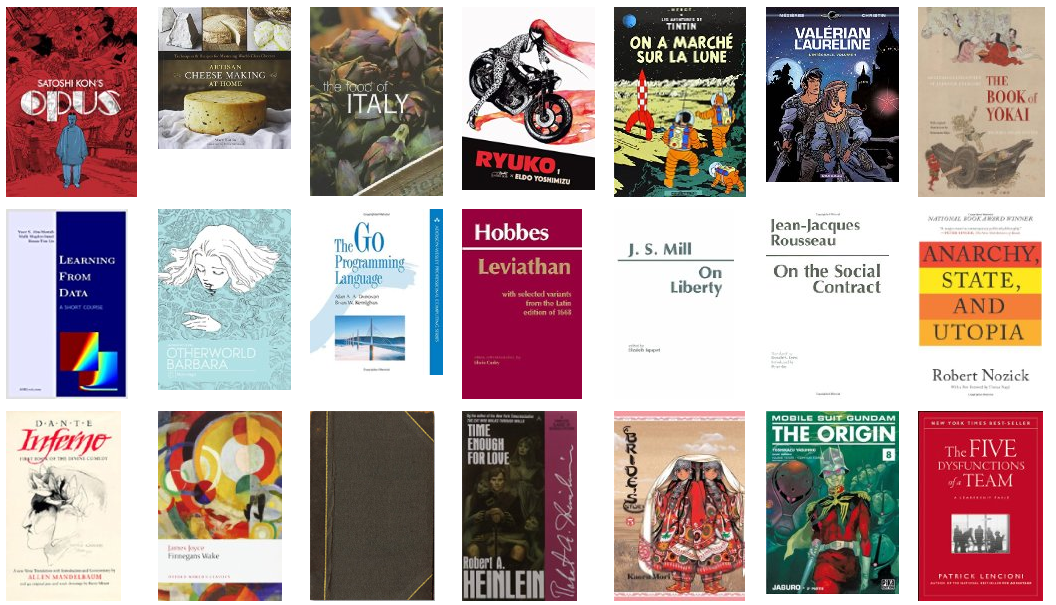
“One cannot read a book: one can only reread it” – Nabokov
I woke this morning thinking about re-reading The Lord of the Rings. The last
stab at the thick volume I made while at Oxford in 2008. A childhood friend
reads the entire thing on an annual basis. Which brings me around to another
question. If I examine the entirety of my library and was given the choice of
only a select few books to read and re-read for eternity which volumes would
that entail? It is said that the quality of a litrary work is measured in our
ability to glean something anew from each reading.
Certainly there are many a book and a film that has touched and moved me greatly
and yet, I would not go back and read it again. Honey & Clover, for example,
was paramount in my decision leave DigiPen for Augustana. Yet, in rewatching, it
has never recaptured the same motive power.
This list then is a kind of “desert island list.” A list of works so profound
that if restricted to only those works on a deserted island I could potentially
get by. It is also the list of works that I could potentially see myself reading
and re-reading every five years into my geriatry.
Books (Novels, Short Story, and Graphic Novels)
The novel is an easy one to figure out. Which volumes have I returned to time
and again? Some of have certainly fallen off the list. C.S. Lewis was wonderous
as a child but what once seemed like playful allegory now feels too much like a
club.
The Classics
- Beowulf translated by Seamus Heaney
- The Odyssey by Homer
- Gilgamesh
- The Holy Bible
The Modern Fantasy
- The Lord of the Rings by JRR Tolkien
- The Hobbit by JRR Tolkien
- The Silmarillion or The History of Middle Earth by JRR Tolkien
- The Works of Lovecraft
- Dune by Frank Herbert
- The Dungeons & Dragons Rulebooks (AD&D, 3rd, and 5th Editions)
The Graphic Novel
- Nausicaa of the Valley of the Wind by Hayao Miyazaki
- Solanin by Inio Asano
The Literary Books
- On the Road by Jack Kuroac
- Child’s Play by Ichiyo Higuchi
- Snow Country and Thousand Cranes by Yatsunari Kawabata
Philosophy
What is worth re-reading in Philosophy is far too long of a list. I submit instead
those volumes from my undergrad that I find worth returning to as they provide a
rather sound foundation for further reading.
- The Complete Works of Plato
- Nichomachean Ethics by Artistotle
- Confessions by St. Augustine
- Summa Theologica by Thomas Aquinas
- Meditations on First Philosophy by Descartes
- An Essay Concerning Human Understanding by Locke
- An Enquiry Concerning Human Understanding by Hume
- Critque of Pure Reason by Kant
- Prolegomena to Any Future Metaphysics by Kant
- The Phenomonology of Spirit by Hegel
- Fear & Trembling by Kierkegaard
- The Portable Nietzche
- Being & Nothing by Sartre
- The Rebel and The Myth of Sisyphus by Camus
Film & Television
Rarely do I return to a film and almost never teleivison. A handful are
regulars, Star Wars, The Lord of the Rings, and Labyrinth where all
watched repeatedly in my youth. The collected works of Miyazaki, Kirasawa
and Satoshi Kon are all revisited on occassion. A handful of anime I would
like to take the time to rewatch as they were all very formative in my youth.
Yet, how well they would stand up on a rewatching remains unknown.
Film
- Star Wars
- The Lord of the Rings Trilogy
- Night on the Galatic Railroad
- Monty Python and the Holy Grail
- Directed by Miyazaki: Castle in the Sky, My Neighbor Totoro, Kiki’s Delivery
Service, Porco Rosso, Pom Poko, Whisper of the Heart, Princess
Mononoke, Spirited Away, Howl’s Moving Castle
- Directed by Kirasawa: Seven Samurai, Rashomon, Ikiru, The Hidden Fortress, Yojimbo,
Sanjuro, Throne of Blood
- Directed by Satoshi Kon: Perfect Blue, Millennium Actress, Tokyo Godfathers,
Paprika
Anime & Television
- Cowboy Bebop
- Samuarai X
- FLCL
- Serial Experiments Lain
- Mushishi
- Kino no Tabi
- Red Dwarf
- The Twilight Zone
Games
The vast majority of games have no narrative arc. How can I return to Counter
Strike? When I examine narrative single player games though, I find myself going
back to Miyamoto’s early games: Mario and Zelda. Few titles from that era
held up with age, and fewer modern titles are worth a second look. Yet, I must
admit that I have probably gone back to re-play none of these games in the last
decade.
- Super Mario I, II, and III
- Super Mario: Yoshii’s Island
- Super Mario 64
- Super Mario RPG: Legend of the Seven Stars
- The Legend of Zelda: Link to the Past or Link’s Awakening
- The Legend of Zelda: Ocarina of Time
- Chrono Cross
- Shadow of Collossus
- Ico
Honorable Mentions
There are a few volumes that I have read multiple times, but upon later reading
in life, I do not feel the same spark and will probably not return:
- The works of Mishima
- The works of Murakami
- The works of Bill Waterson
- The works of C.S. Lewis
A quick run down of all the films, shows, books and games watched, read and
played over the last year.
Film & Shows
This was the year of film. Starting in the FEMA trailer in Clifton, the big
screen TV that came with the new house. We had every excuse to watch movies. We
are running low on Hitchcock and Price films at this point. There are so many
of them (over 30 in total!) that I can’t give time for each. Instead, I’ll just
break each down to a letter grade.
Not mentioned, but started Steven Universe, FMA: Brotherhood, The Guild,
Amanchu, Dark Mirror and Flip Flappers.
Q1
- Moment A
- Star Wars: The Force Awakens B+
- A Boy & His Dog A
- Dogma B
- Limmey B
- The Revenant D
- The Life of Pi B+
- Theatre of Blood C
- The Wrong Man C
- Erased (Anime Series) C
Q2
- The Hills Have Eyes D
- Alice Through the Looking Glass C
- Iron Man D
- Big Fish C
- Kiznaiver (Anime Series) D
- Kabaneri of the Iron Fortress (Anime Series) A-
Q3
- One Punch Man (Anime Series) B
- Suicide Squad D
- The Haunting C
- The Edge of Tomorrow B-
- The Enemy of the State B
- The Conversation A
- Night of the Hunter D
- Crimson Peak A-
- Central Intelligence D
- Now You See Me 2 D
Q4
- The Babadook B+
- From Beyond the Grave C
- The Asylum C
- Stir of Echoes C
- Scott Pilgrim vs The World C+
- John Wick C+
- I Am Big Bird B-
- 13 Assassins B-
- 2001: A Space Oddyssey A-
- War Dogs C+
- Rear Window B
- Shadow & Fog A-
- Chinatown A
Books
Not mentioned, but started Queen Emerladas, Galaxy Express 999,
Peopleware, Ryuko, The English Calendar, and half a dozen Science
Fiction & Fantasy Magazine volumes.
The Martian
Saw the film, decided to read the book. The book is very detailed, and very
slow. I think it worked better as a film, as the book was very much written for
people who would want to geek out over the science in it.
Table Titans
Read the backlog of Scott Kurt’z other comic. Glad that I waited for
something of an archive to build up. The comic can be slow reading as a daily
but the backlog helps hook me in.
Get A Grip
Another business narrative for those who like to imagine that they’re
executives in the book and not just another drone trapped in whatever political
mechanations middle management has in store for them. Okay, I’m being overly
cynical but I would like to see more business books written from the
perspective of running teams for the middle manager or line man and how to
handle the demands that stem from both above and below. It seems like a cheap
cop-out to write your book about C-level executives who appear to be free to
steer their business willy-nilly.
Showa
An amazing historical record of pre-war Japan and an important read in light of
our current political times. It is fascinating to watch how a progressive
forward thinking government can be erroded and transformed into the fascist war
machine just a few decades later.
Democracy Incorporated
I really like Steve Wolin’s idea of managed democracy. There are some good
ideas in this book. However, I struggled to get over Steve’s apologetics for
the Democractic party. It would reason that the Democrats are as much a part of
managed democracy as the Republicans and share just as much of the blame for
our failures. Elevating them up as the true will of the demos seems wishful
thinking.
The Life Changing Tidying Up
People kept talking up this book, and I’ve been struggling this last year to
really minimize my life. This would have been better as a pamphlet. There were
a handful of useful tips, but they were all lost in the flood of prose.
Solanin
This is the fourth or fifth time through Solanin. At this point, I’ve read it
at quiet a few different points in my life. As an unemployed post-collegiate
student. As a young man starting hist first relationship. And now as a young
man having been in a steady relationship for five years. It’s a rare book that
continues to speak to you each time.
Stand Still Stay Quiet
Well written, absolutely beautiful modern take on a lot of Scandinavian lore. A
zombie story, with monsterous trolls, ghosts of the dead, and a ravaged Europe.
A lot of fun, although I’m begining to get the feeling that the characters have
plot armor. The early story really built up the trolls as being nearly
undefeatable. Scourging entire military operations. Laying waste to cities.
Yet, our rag-tag team takes them out like to much butter.
Alice Grove
Jacques should stick with coffee shop banter. I just can’t take his style or
characters seriously. Love QC though.
The Go Programming Language
One of my long standing complaints with language books is that so many of them
are written for the absolute novice. The first section goes through different
variable types. Basic boolean logic. Maybe by the later half of the book can we
get into the meat of how to use the language to get things done. The Go
Programming Language is excellently written not for that novice. Rather,
it’s written for the experianced programmer trying to get started and
productive with Go fast. In this respect The Go Programming Language succeeds
amazingly.
Otherworld Barbara
A really good brain teasing science fiction text. Another volume that I simply
had to read in a single night.
Games
Not mentioned, but started Pillars of Eternity, Borderlands II, Too the
Moon, and some time on Graal Online and Eve Online.
Firewatch
Wow. It has been a long time since a game hooked me to the point where I stayed
up until dawn just to see how it ended. The story, characters, atmosphere. The
80s era camping gear of my childhood drawing in that sense of western camping
nostolgia. I’ve lived up at Black Rock. The game captures the feeling and
remoteness of Wyoming.
Undertale
There were so many people on Facebook and Twitter that kept recommending this
game to me. It took me three tries to actually get into the game. Each time I
stopped right around where the skeletons appeared. The game play in Undertale
is really simplistic, too simplistic. But after a slow start, it gains some
momentum. It’s enough to get me to the end of the game, but not good enough
that I would bother playing through it over again to get all of the endings.
Torchlight II
Torchlight II starts out very slowly, but becomes extremely fun in the late
game once the characters have access to their full arsenol of spells.
Unfortunately, this also seems to be the point in which game breaking bugs
start to appear. We had enitre unplayable nights because of players not being
able to join games or the AI simply bugging out and refusing to interact with
us. For a game that’s been out for years, I would have hoped these issues would
have been fixed by now.
To match up with the list of books and films read or watched in 2015 is a list
of books that I hope to get to this year. There are a lot of re-reads in here. I
am finding that as I get older I am much more inclined to step back and re-read
a good book then I am to always be searching for the next great thing. I’ve also
grown a lot more choosy on what it is I do start up reading. There just isn’t
enough time in a year to rush though a paperback a week like I did way back in
High School. I also suspect the list will evolve substantially as the year goes
on based upon my seasonal whimsy and discovery of new authors.
*Re-read
Fiction
(Total: 22)
Novels
Graphic Novels
Non-Fiction
There is no way I will be getting to all of these volumes. For a lot of them,
like Pic Iyer’s Falling Off the Map, The Open Road, and The Art of
Stillness – I inclined to only read one. Likewise, a lot of the philosophy
texts, I doubt I will be getting to all of them. And my employer also gives me a
reading list of sorts which I haven’t added to the pile of computing volumes.
(Total: 27)
General Non-Fiction
Computing
Philosphy, Zen & Theology
Roleplaying Game Rulebooks
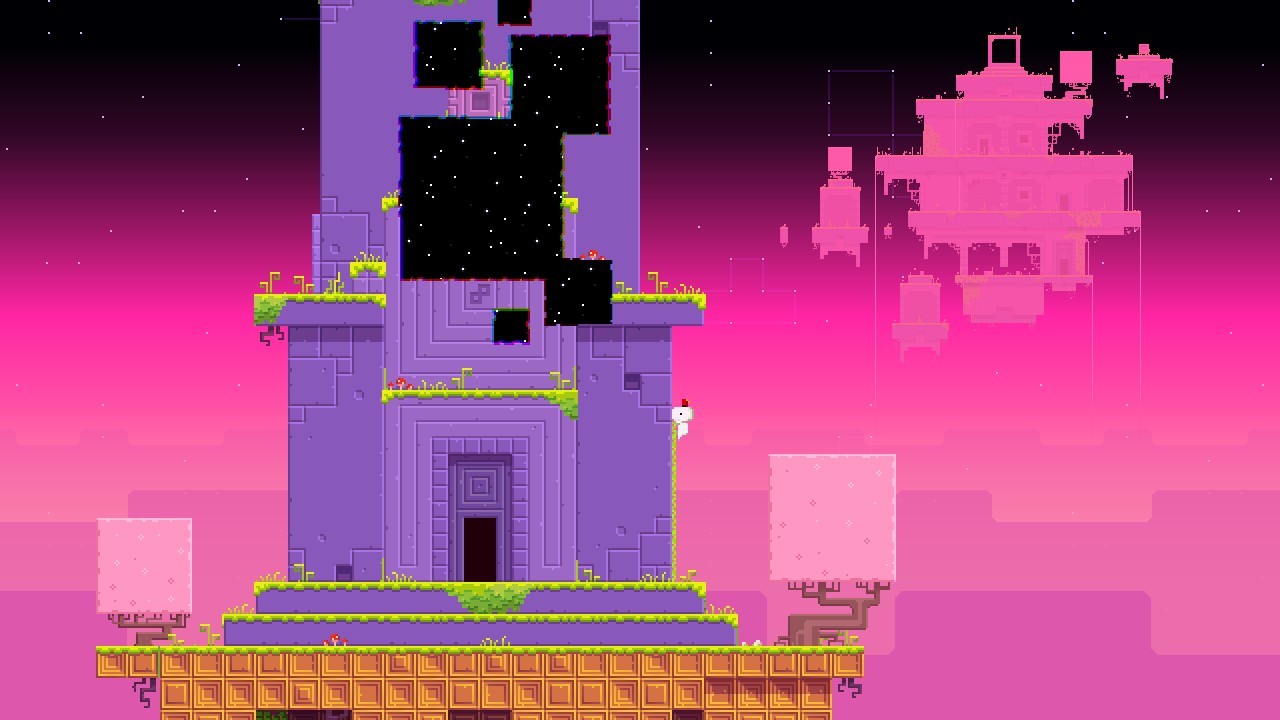
I have a new post over on the Wind-Up Culture Blog concerning the the
extraordinary polish of Fez. Right now, I’m
at 82% of Fez completed and the game continues to blow my mind away with the
complexity of this indie title.

I am struggling to find the words that adequately describe the simple joy that
is Fez. I think the word that I most often find in my
reflection is complete. That is, I think Fez is a more polished and “whole” game
than many a modern Triple-A title.
Concerning Publishing Unfinished Games
It has become too common to see games placed on shelves before they are truly
finished. I could point the finger at any number of triple A titles (mostly in
the MMORPG and FPS genres) wherein the release of the game is done before
production has really honestly finished. But the most brazen releasing of
unfinished games seems to come from the Independent scene where often games seem
more like tech demos then completed titles.
These unfinished games are hobbled together and released while their ideas are
still weak and unrealized. They lack the true polish that is necessary to fully
explore their game-play potential. Graphics are unpolished with no eye for
creating a cohesive aesthetic. Game-play consists of repeating the same simple
mechanic over and over. And content is either procedurally generated, random, or
simply lacking in complexity and attention to detail.
These poor unfortunate children are cast out into the marketplace and I am still
surprised to see so many titles getting praised despite their severe flaws.
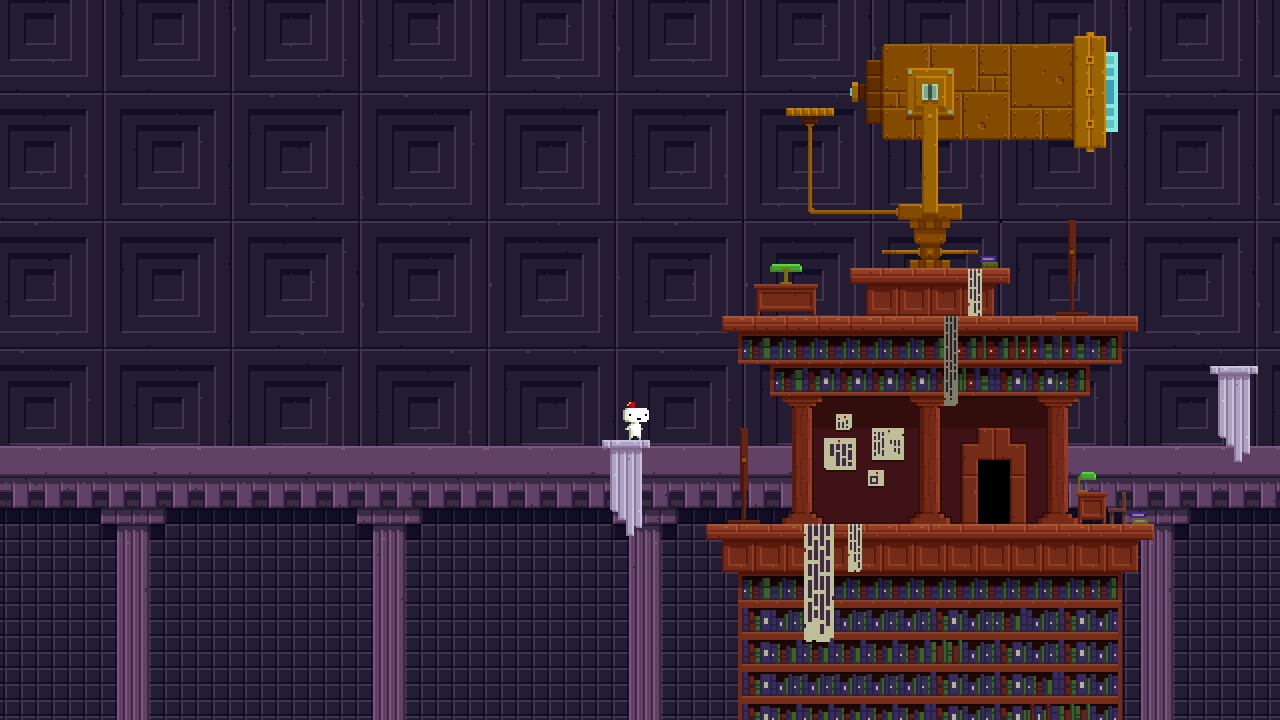
Unity of Ideas in Fez
When I look at Fez what I see is a gestalt that creates an exceptional sense of
unity in presentation. The game is whole and explores its ideas sufficiently to
fully showcase the game without exhausting our temperament. I am reminded of the
original Super Mario Bros in that it is a game that could be beaten in a short
time but yet each piece – the art, the arrangement of the platforms, and
progressive difficulty was a creative expression that created an ensemble that
far exceeded it’s parts. Indeed, had one platform been off, had one level simply
felt as though it was a hap-hazardous assembly of ill thought ideas the entire
idea would collapse. But we do not see this with Fez, instead we see a kind of
excellence found only in minute attention to detail that encourages us to
immerse ourselves in the scene feeling secure that it will not disappoint us by
failing to reward our explorations.
In essence, we have a game whose levels encourage a kind of tranquil enjoyment
of each scene – the dog laying to sleep, the strange hieroglyphics adorning the
walls, and pixel-perfect skies. The developers behind Fez certainly felt the
need to reward such careful exploration as without the desire to wander about
the levels solving Fez’s mind-boggling puzzles becomes nigh impossible.
That is, the process of rewarding for exploration is built into the game. On one
level spinning a globe reveals hidden treasure maps. On another turning a valve
lowers and raises the water table on a completely different level. Puzzle pieces
reveal that what looks like decorative glyphs in the game may be a part of
solving a larger puzzle. Rather than punish us for wandering beyond the linear
paths and only rewarding us for progress, Fez rewards us for returning over and
over again to the same places to look again. Our approach to each level is
hyper-linear and this hyper-linearity creates a sense of choice not found more
linear narratives.
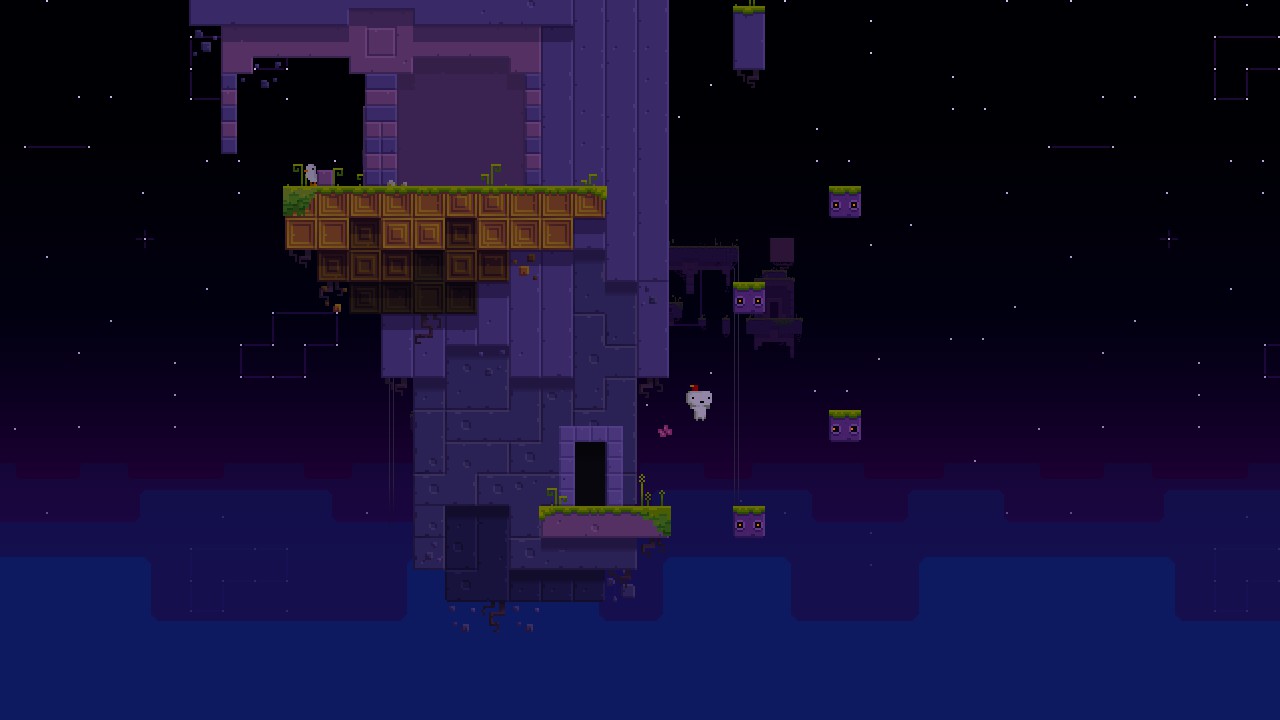
The Game-Play of Fez
The stages of Fez go on far beyond what I typically expect of an independently
produced title. We find such a variety of unique realms that rarely repeat their
themes – haunted mansions, seasides, jungles, and libraries.
Each stage reveals such a wealth of history into the eight and sixteen-bit eras.
We see tetris blocks built into the levels, Owls that look remarkably like those
found in Zelda, and a story that winks at the 2D “worlds” that exist inside our
computers as our hero sets off to save the world by collecting cubes all the
while electronic tears appear all about him in the world.
The idea of exploring a 3D world collapsed onto a 2D plane while still allowing
the user to change the plane of collapse is not a new one. Mario explored these
visuals in the various Paper Mario titles. Portal, likewise explores the bizarre
possibilities of physics-breaking that video game space can produce. So, like so
many other games before it, Fez is not something truly new but an exploration of
something that has come before.
But it is not the exploration of something new that makes Fez, or many great
games great. It is once again the fact that Fez is complete, polished and a
unified example of it’s kind.
Okay, Portal 2! What could be said about Portal 2 that wouldn’t already be
known by anyone who stumbles upon this blog?
Portal 2 is amazing? That’s a given since this is a product of Valve we are
talking about here. Valve just does a very good job on it’s games and Portal 2
is no different. This is a product that has been polished until not one little
error remained. Every line of dialog is a pleasant suprise, every puzzle an
innovative joy and I am only sad that it is so short.
For those who may have been laying beneath a rock – Portal 2 is a
first-person puzzle game built using Valve’s Source engine, that is the same
engine responsible for the likes of Team Fortress, Left 4 Dead, and
Half-Life 2. Except instead of focusing on run-and-gun gameplay, Portal uses
the first-person perspective for an entirely different take. Your gun shoots
portals. Left click and it sets an entrance on a wall. Right click anywhere else
and you create a doorway that will take you from one space to the next.
It’s like playing in an M.C. Escher painting and the challenge is simply being
able to visualize the problem of moving between point A and point B. At first
this is rather simple. Shoot a portal on a wall, put another one somewhere else
and hop through. But the puzzles become increasingly challenging as the game
progresses requiring a great deal of creativity upon the player’s part to simply
navigate the levels.
And as a companion to your trials you get a collection of some of the most
delightful, twisted characters that I have seen in a game before: GlaDOS,
Wheatley, and Cave Johnson exist to torment, mock, and serve up a kind of
science-experiment-gone-wrong scenario as Chell (our protagonist) delves into
the bowels of Aperture Science to uncover where it all began.
If I am beaming about the game it is because it is just that much fun. It has
been a long while since I hit a game that I just could not put down and Portal
2 is definitely hard to put down.
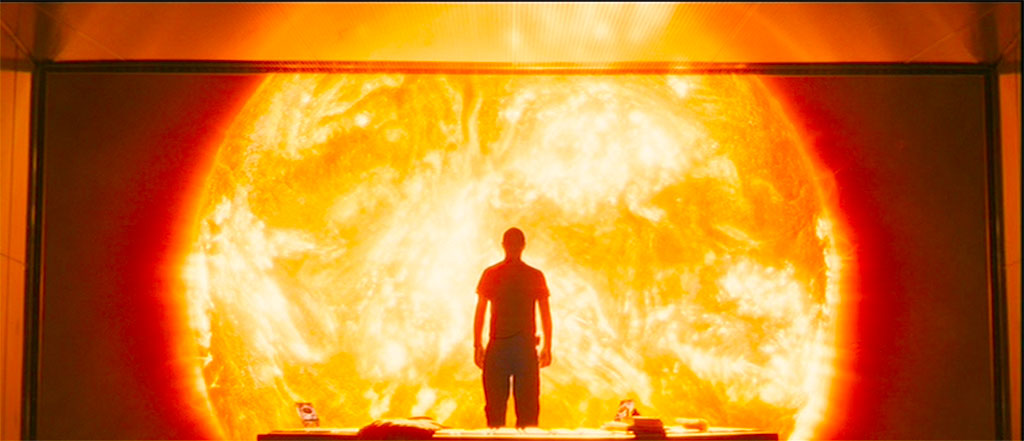 I
came upon the film Sunshine by way of the exemplar Moon. The latter being
perhaps one of the best instances of hard science fiction that we have seen in
theatres since 2001 A Space Odyssey. Sunshine, while a very good film, cannot
live up to Moon simply because of some very basic plotting issues. Nevertheless,
it is a very interesting science fiction flick.
I
came upon the film Sunshine by way of the exemplar Moon. The latter being
perhaps one of the best instances of hard science fiction that we have seen in
theatres since 2001 A Space Odyssey. Sunshine, while a very good film, cannot
live up to Moon simply because of some very basic plotting issues. Nevertheless,
it is a very interesting science fiction flick.
Sunshine works on the premise that in fifty-some years the sun’s light has begun
to dim plunging the earth into an eternal winter. In order to revive the fires
of the sun, Icarus was sent to detonate a payload with “the mass of Manhattan”
into the sun’s surface. This mission, for unknown reasons failed. The film
begins following the second mission (Icarus II) as it retraces the steps of the
Icarus I in an attempt to follow up on the same mission.
This is decidedly a psychological film — one that draws upon many past science
fiction themes of the lonesomeness and vastness of space and how this conveys
the minuteness of humanity in the cosmos. It is particularly interesting how
involved the main cast gets into the sheer importance of their mission and the
willingness to throw everything away for their mission. That said, they are very
human characters, not the machismo heroes of the action-suspense genre we often
see out of Hollywood.
The sun, our antagonist, plays so many roles for our heroes as they address it
both as a villain who threatens the ship and with a kind of spiritual reverence
held by various pagan sun gods.
The very name Icarus seems to very important to understanding the film. In the
old Greek myth, Icarus is the son of Daedalus the inventor. The two are
imprisoned onCrete and in a stroke of genius Daedalus constructs wings for the
two to escape the island by flying through the heavens. Daedalus warns Icarus
that the wings are fragile and made of wax which will melt if he flies two close
to the sun. Nevertheless, Icarus is too taken up with the excitement of flight
and flies higher and higher until his wings melt and he plummets into the sea.
Herein we can see the fate of Icarus the ship — a work of technological
achievement sent on a mission to visit Apollo himself. In flying so close to the
sun, it chances total destruction by it’s firing furnace and only by a massive
aspis-styled that reflects the sun’s light.
Returning the mythical elements, the crew seem to be in awe of the sun. They
spend hours watching it’s furnace glow, talk reverently about it, and dream
nightmarish dreams about it’s flames.
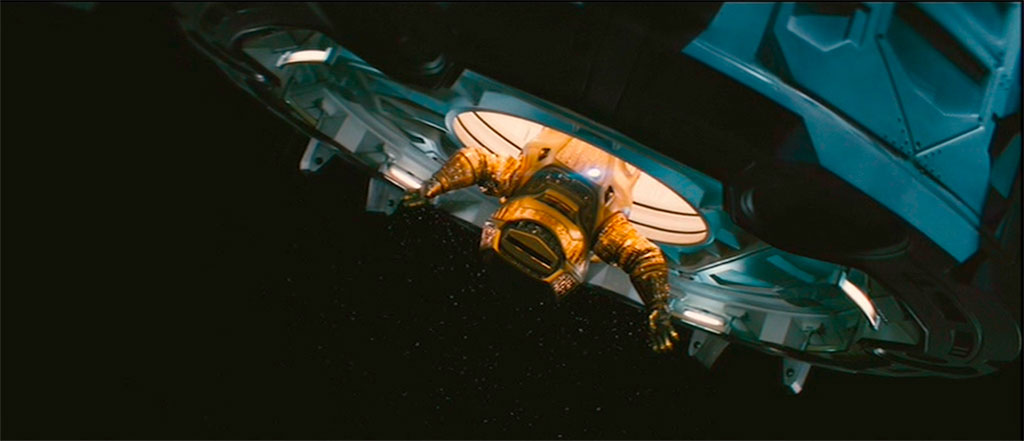
The only issue with Sunshine? Besides introducing the ridiculous cliché of an
accidental oxygen shortage, the third act forgets who it’s antagonist is. The
sun, such a perfect villain for a man-vs-nature plot is supplanted by the mad
captain of the Icarus I who boards the ship and turns an otherwise amazing film
into a run of the mill slasher flick. The captain, burnt by the sun’s rays, and
having lived alone aboard the Icarus I for seven years believes the sun that the
sun is God and that it has commanded him to abandon the mission.
While I can appreciate the sun-god motif in the film and the interesting
questions that Sunshine brings to the table about how we have related to our
star over the centuries — the rabid fundamentalist captain is out of place in
this film. He suddenly interrupts our story and transforms it into a battle
between science and fundamentalism or man-vs-man which is not altogether what we
have been promised in the first two acts.
Indeed, the violence that the deprived captain inflicts upon the crew is a
merger of horror into an otherwise fulfilling film. I do enjoy the occasional
cerebral horror film. However, in Sunshine I was not expecting a razor-blade
wielding maniac to suddenly appear and displace the sun from it’s dominant role
of antagonizing our heroes and I do not think his addition adds anything to the
film other than to pad it out an extra twenty minutes.
Despite the plotting flaws, Sunshine is an excellent example of how cinematic
science fiction can rise above the empty plots ofHollywood action-suspense
flicks into truly masterful pieces that explore our relationships with being. I
highly recommend watching it.
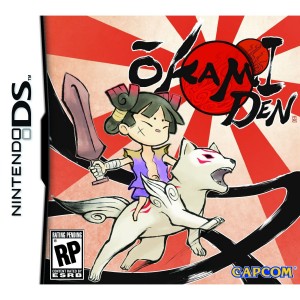
Today I finished an adventure that I had started out on just a mere 24 hours or
five months earlier:
Okamiden.
My initial apprehension towards Okamiden rapidly faded as I began to get into
the game and realize that in it’s complexity it was far more than just a scaled
down rehash of the seminal PS2 Okami. From combat, to brush strokes, to
atmosphere and plotting the game has nearly everything that it’s big brother
has.
Gameplay
My initial impression dwelt heavily on Okami’s scaled down gameplay at it’s lack
of features. I now have to eat these words. Although the button-mashing aspects
of combat are scaled down to just mashing A to attack, the ease of using brush
strokes on the DS makes the spirit brush an integral component of late-game
combat. As I began collecting slicing, lightening, fire, and wind strokes I soon
found myself combining them into effective combos: wind to knock an opponent on
the ground, rain or lightening to slow and trap them, then close in with a
couple of bombs and basic attacks. I would say that by the end of Okamiden it
had the combative depth of Okami.
Dungeons were likewise exemplar. Puzzles made liberal use of companions special
abilities and combinations of brush strokes to activate devises. I found myself
taking my time in many of these places to really explore all the rooms, solve
the extra puzzles and pick up every last scrap of artwork I could find. I don’t
think I have so thoroughly immersed myself in the exploration aspects of a
dungeon crawl since Ocarina of Time.
Aesthetics & Plotting
Okamiden is gorgeous and I am rather surprised that the aesthetics of Okami
could scaled down so perfectly to fit onto the DS’s small screen. Yet, here it
is completing with music, sounds and tantalizing natural scenes.
Okami suffered one issue. It jumped the
shark in its
plotting. The early gameplay introduces eight-headed dragon Orochi and for the
large part of the tale we believe that we are somehow fighting against this
beast. Yet, we defeat him two thirds of the way through the game and are
suddenly a new demon turning the progression of the story completely on it’s
head. The result is a feeling that the later half of the game had been rushed
and lacks the detail of the first portion of the game. The ending seems a tacked
on after-story to the quest to lift Orochi’s curse.
Okamiden, on the other hand, feels like a much more complete narrative. The
major plot turns are well foreshadowed and we expect these surprises – Kurow’s
betrayal and the appearance of Akuro make sense from a narrative perspective.
I feel that Okamiden is a complete adventure title. Unlike the DS Zelda titles
which I think attempt to be minor iterations in the overall Zelda lineup –
Okamiden simply feels like a full fledge title and not a scaled down hand-held
port of it’s predecessor. I hope that it sees some good success on the handheld
platform and look forward to the continuation of this franchise. Kuni’s tale
deserves to be told.
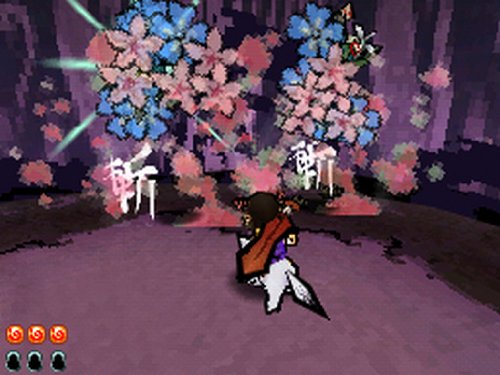
It was my luck that The Secret World of Arrietty came to Sioux Falls. This is
my first Ghibli film that I could see in its proper setting: the big screen and
I must say that it was a spectacular treat for the eyes, replete with stunning
backgrounds and gracefully animated characters who play out yet another
fantastical story. While Arrietty will probably not be my most favorite Studio
Ghibli film, it does possess the wit, charm and magic that I expect from the
creators of Spirited Away, Howl’s Moving Castle, and Princess Mononoke.
It’s only real lack is in it’s pacing, which seems much slower than past fare
and for some may be too slow.
I happened to watch Spirited Away the day after seeing Arrietty and it
occurred to me how much sense of atmosphere Ghibli creates in their films
through the deep sense of place and connection that chracters have with the
environment that they occupy. Ghibli certainly pays very close attention to the
details in it’s stories and illustrations and I think that this sense of
environment is just one example of stroytelling that makes their films so
tremendously delightful.
Environment in story informs the characters and plot, or at least it should if
the author is paying any attention to their setting. A character who is actually
living in their world will face the unique limitations that their environment
creates – their culture, actions, and life will all be informed by this
setting. Ghibli films realize this reality in a way that so many other films
simply ignore. Their worlds draw upon the ambient emotions that nature’s many
forms (violence, tempered, serene, and sublime) create in the human psyche. Let
me take a quick glance at a few Ghibli films and illustrate how this plays out:
Princess Mononoke
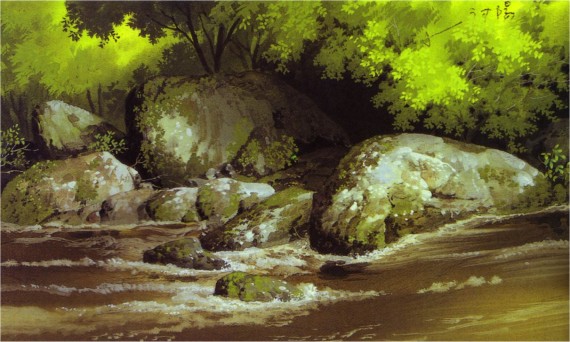
The atmosphere of Mononoke drips of the time when the wilds were an alien and
unforgiving place for mankind. Early on in the film we see the difficulties that
civilization has sought to overcome: the danger of predatory animals (Moro), the
difficulty in navigating the wilds (the muddy and treacherous caravan trips),
and deadly weather. Yet, nature still possesses a sense of serenity. The Emishii
peoples seem to live a harmonious existence with nature as does San. The
characters who find nature the most brutal are the ones who act the hardest to
work contrary to their environment. Overall, the scenes create an atmosphere
that mimics the internal difficulties of each scenes principal characters. For
the caravaners the woods is a dangerous, frightful place but in the hands of
Ashitaka the woods becomes a land of delightful and helpful spirits –
the differences not in the woods, but in how the characters approaches dealing
with their sense of place in the natural world.
Spirited Away
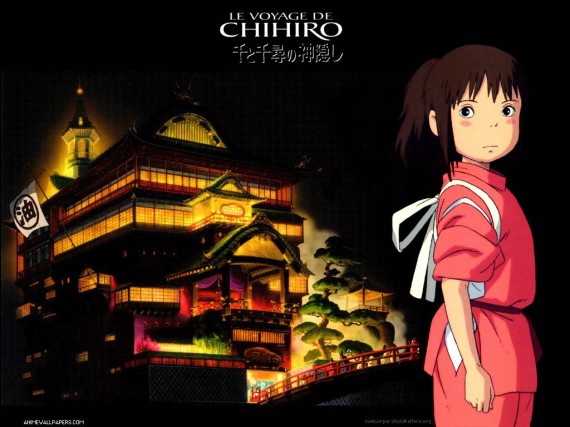
Since Spirited Away takes place in a bath house and not the wilds we see a
very different approach to place. The bath house of Yubaba is a fusion of
Japanese and Chinese aesthetics that exaggerates the more gaudi elements of
Chinese style and completely abandons Buddhist simplicity in everything but its
depictions of the natural world. The bath house is simply an extension of
Yubaba, who is a greedy and gluttonous crone. We see these characteristics not
only in her employees but reflected back to them by Noh-face who absorbs the
essence of the place as he stumbles about eating the staff and flinging gold
about. Not until he disgorges the filth of the bath house can he go back to his
simpleness.
The Secret World of Arrietty
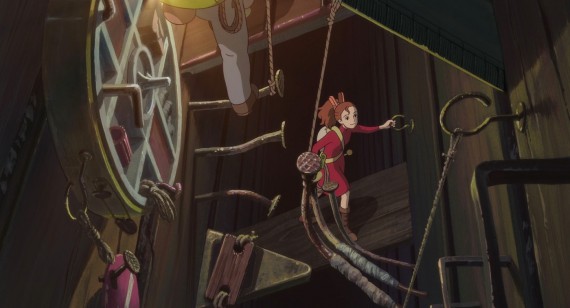
The world of the borrowers takes on a much more realistic charm that lies less
in the fantastical elements as much as trying to showcase how the borrowers
would interact with their gargantuan environment. Arrietty’s family lives in the
walls of houses where they make their way about using ropes, nail staircases,
and simple free-climbing techniques in an adventurous method that reminds me of
real-world caving. They “borrow” from their environment as they take only what
they need from the Beans who they both live beside and in fear of. I think in
Arrietty we see a kind of modern Emishii where their lifestyle nurtures a kind
of connectedness to their environment that emphasizes a sense of propriety over
taking only what is needed while leaving the superficial (the gaudy playhouse)
behind.
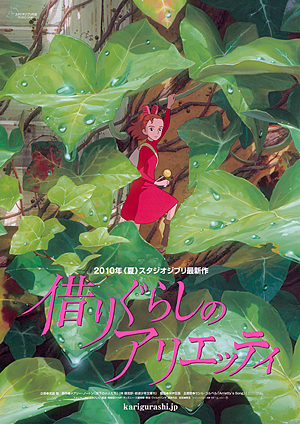
I saw the trailer to The Secret World of
Arrietty when I went out to watch The
Muppets back in November. Now mind you, I was out on Thanksgiving break
visiting my folks in the frigid north of Escanaba, Michigan. The Northern
Midwest is not know for its taste in eclectic films – theaters up there
typically run the top selling Hollywood flicks of the week and little more. So
you can imagine my delight to see a Studio Ghibli
film being advertised in such a mainstream venue!
It seems that this is a new move for Disney, which according to The Ghibli
Blog,
will be promoting the film with a release in 1,200 theaters this month.
Unfortunately, from what I can find: there is no release scheduled for Sioux
Falls. So I’m either going to have to drive or wait for the DVD release.
On a lark, I went out to WestMall7 and choose to watch
whatever film happened to be airing. Now, WestMall7 is Sioux Fall’s second-run
theater. Its good for its cheap popcorn and cheaper tickets. Although, much of
the popcorn seems to end up on the floor in this place and The seat cushions, I
believe, are from the 1980s – the springs long worn out.
I have been avoiding WestMall7 for the last couple of months on account of there
being no good films out. The Christmas flicks have yet to hit the screen and the
flicks that aired between the summer blockbusters and the holidays are a rather
large collection of duds. I settled on The Darkest Hour
as what seemed the least worst film.
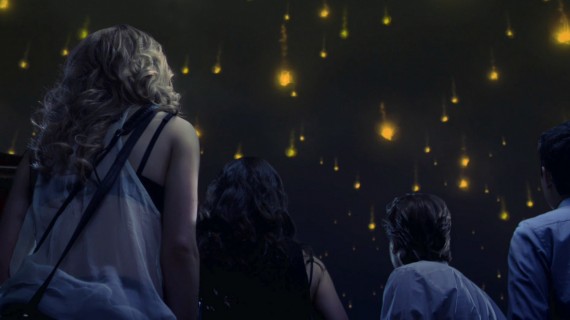
The Darkest Hour is about a group of early twenty-some-things trying to escape
Moscow after an attack by an alien force. The film follows the fairly routine
alien invasion that we have come to expect from the offspring of The War of the
Worlds. Although, unlike Independence Day which attempted to modernize War
of the Worlds with a computer virus rather than biological virus – The
Darkest Hour falls into a distinct escape from the invisible monster scenario.
I expected this film to be one of the laughably bad kinds. The marketing
department that designed this film must have thought that the audience wants to
bond with Mark Zuckerberg impersonators and the bubbly-headed American tourist
girls who seem terrified to be outside of their home country.
Empty characterization aside, some of the ideas in The Darkest Hour are rather
interesting and if the writers explored these ideas in a more unique manner
(rather than hacking together a cookie cutter sci-fi flick) we would be walking
away with a much different impression of the title.
For example, the aliens of The Darkest Hour are energy-based life forms. This
idea has been explored in written and televised works, but never in this much
depth. The characters face a difficult challenge in defeating and understanding
an opponent that is essentially invisible and detectable only through the
destruction is creates and side-effects that it has on electrical equipment.
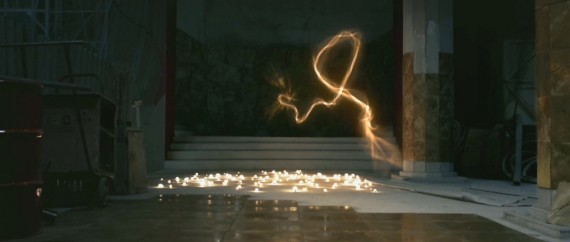
Nevertheless, these ideas are never really explored. The protagonist explains
them away in narration – why they want to attack earth is never explored, but
just given to the audience, much like the characters are given each of their
solutions to the alien threat. Midway through the film, after just days from the
initial alien attack, mad scientists suddenly appear seemingly anticipating the
attack and armed with portable electron guns and protective faraday cage
hideouts. Militias appear who seems to have a deep understanding of their
invisible opponents and have developed technologies and tactics to defeat these
invaders that belay more skill and artifice than could be learnt in a weekend.
Hence the largest issue in The Darkest Hour: pacing. The protagonists shelter
during the early invasion in a cellar and emerge a week later. In that time, it
seems they have been transported twenty years into the future.
Other issues abound. The protagonist discovers that the aliens are blinded by
glass. Yet the writers ignore this fact when the aliens, from the street, spot
the characters rummaging inside an apartment building hundreds of feet away.
Likewise spatial logic is redundant as one character falls off a boat and ends
up transported miles away across the city. Are we to suppose that upon reaching
shore she decided to walk away flee from her companions rather than attempt to
meet up with them at their destination some hundred yards down river?
I am glad that it was a mere three dollars to see The Darkest Hour and I
should hope that in the future such ill thought works can be kept to the SyFy
channel.
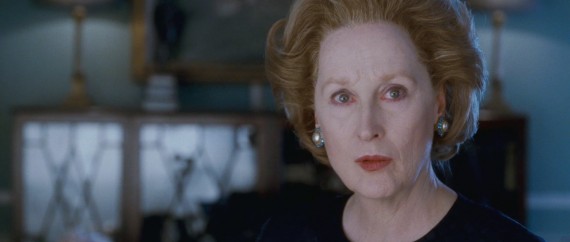
I recently attended a showing of The Iron Lady
at the bequest of my girlfriend. I was
initially reluctant to see such a production – not because of some distaste for
a biopic of Margaret Thatcher, but because I feared that it would just be a
simple film riding on the coattails of last year’s The King’s
Speech.
The King’s Speech won four Oscars last year and for a very good reason. It is
an eloquently produced work illustrating the changing political climate of
Britain as it transitioned from the Victorian into modern times. Yet, here we
are one year latter with yet another film about yet another British ruler. How
can I not consider this a grab on the prior work’s success?
Nevertheless, I was surprised to find that The Iron Lady can stand upon it’s
own accord. I knew little of Margaret Thatcher going into the film, save that
she was an influential Conservative party politician in Brittan through the
seventies and prime minister through the eighties. Folks still talked and argued
about her influence when I went to Oxford just a few year’s back. She seems to
be a rather reviled women and yet surprisingly influential on British society.
The Iron Lady showcases a kind of highlight reel of Thatcher’s life. A few
scenes from before her entrance into politics, her campaign for leadership of
her party, a handful of NRA inspired terrorist attacks, the Falkland’s war, and
her eventually fall from authority. Overall these scenes are rather touching and
masterfully performed by Meryl Streep.
Yet, he film spends it’s time predominately dealing with her current dementia.
This is surprising since there is such a wealth of material from her actual life
as the first female Prime Minister of Brittan and this dementia deals so very
much with her late husband who is scarcely found in her historical remembrances.
My initial response to the film was delight. As a biopic, I walked away rather
inspired to hop online and research more about Thatcher. As the days pass
however, I find myself more and more caught up in the film’s narrative failures
in a way that I did not feel with The King’s Speech. Indeed, whereas I might
go back in a few years time and enjoy The King’s Speech again – I do not
think I shall do so with the The Iron Lady.
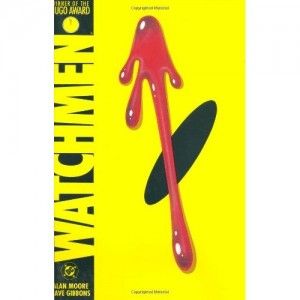
I wrote a short review about Watchmen back when the film came out
in theaters and while I have read the book, I wish to address the film in
particular. I will be revealing a lot of the plot devices in this one, so if you
haven’t had the chance to read or watch the film, I say skip this and come back
once you have.
Watchmen is to Super Hero films what Neitzche is to Nihilism. It would seem at
first that Watchmen is just a grittier version of the Super Hero genre. Filled
with anti-heroes, sex, violence and the dynamics of less-than-perfect humanity,
the work portrays itself as being a critique of Super Hero romanticism.This may
be true in the graphic novel, yet the film takes this concept slightly further
in its alterations to the ending.
Through the earlier sections of the film we are introduced to a post-Neitzchian
society. The ambitions of man are kept in checked by a careful balance of
political power. Russia and the USA have the bomb, but the USA has Dr. Manhattan
– a superman with the power to see through time, cause people to explode, and
any number of other powers. This superman is Neitzche’s ubermensch. Yet, his
mastery is bent to the futile intrigues of his surroundings and he has become
disconnected with mankind and he begins to see past man and into their empty,
futile attempts to placate fate. The greater part of society is now living
post-god in which man exists not in fear of some retributive all-powerful deity,
but must only fear the retribution of his fellow man. Such fear was kept in
check for a while by the threat of the vigilante”Watchmen,” who superseded the
law authority to enact retributive justice upon lawbreakers.
Here is that central theme of Watchmen: is there any justice at all? Certainly
it seems in the text that the justice of the political fails to address the
people’s needs to see justice served. Society is rank with villainies such as
robberies, murders, rapes, and muggings. The Watchmen, more or less, are also
not the answer to justice as each of them pursues their own particular view of
justice which in the end is merely self-serving. Heroes such as Silk Spectre or
the Comedian are merely in it for the fame and power and Nite Owl is fueled by a
sense of wishy-washy moralism that exists more out of expediency than
the virtuous determination we see among Super Heroes. We see fellows trying to
rise up to the status of Nietzsche superman. They establish these self-made
virtues but cannot follow through with them, and so fall back into the line of
the society of men. Watchmen’s society is thus that of a nihilism, not
Nietzsche’s self-determinant society of supermen and the answer in Watchmen is
not that of the existentialist, but of the necessity of re-establishing God in
order to keep man in line.
Look at the film’s end. Viedt’s mastermind plot is to subvert nuclear war by
attacking first. He nukes all of the super power’s city centers using weapons
designed to look like Dr. Manhattan’s unique radioactive signature. These
attacks force society to re-evaluate itself and come together in the realization
that they have much larger threat to mankind: Dr. Manhattan. Dr. Manhattan is
thus God incarnate, a new kind of messiah who saves not through sacrificing
himself, but by sacrificing the rest of the world. This is the vengeful God of
the old testament who will suffer none of the squabbles of humanity. By
providing the world with this new-found maker of miracles (or ought I say
plagues), Viedt reveals that God is very much alive and he is a giant blue man.
Dr. Manhattan, fed up with meaningless bickering of mankind, leaves earth for
the sterility of the heavens where Viedt can assure the people of earth he is
watching over them carefully. Again that father-figure is restored into culture
and the nihilist society is resolved not by truth but by the re-establishment of
a great lie.
Rorschach, however, is our true super hero. The man who is fighting for truth
and very much believes in justice. Viedt, and ultimately Nite Owl believe
in alleviating suffering not the upholding of an abstraction like justice. In
the world of the Watchmen there is no place for a man who truly believes that
there is justice. Such a man would be absurd or “nuts” as Rorschach is referred
to by his fellow super heroes. Yet if we superimposed Batman, Superman,
Spiderman or any other superhero into this space they to would be seen as
hopelessly naive at first, and if the hopelessness of society didn’t drive them
to the madness of Rorschach then they would be rather unbelievable. No,
Rorschach is representative of a desire for a just world. He wants a world that
is more than just nice, where people are pleasant and freed from suffering. He
wants a world were justice is seen to and the people virtuous. Such a man cannot
live long in the mockery that Viedt creates: the world of lies that we live in
as we tell ourselves that all is right and just in the world. In the end,
Rorschach is killed by Dr. Manhattan because there is no place for a just man in
such a world.

I recently procured a copy of Apollo’s Song which, like many of Tezuka’s
works, is printed in a thick 500+ page single volume. The first English run was
in 2007, and currently is out-of-print according to Amazon. Nevertheless,
Vertical has a good reputation for keeping its library in print and has
republished the text in a two-volume series.
Apollo follows the lives of Shogo, a young boy whose admitted to
a psychiatric hospital for his atrocious abuse of animals. Due to an abusive
upbringing by a prostitute, Shogo is unable to love and finds the pairing of
even animal mates repulsive. During his first treatment of shock therapy, Shogo
experiences a vision in which he is visited by Athena, the greek Goddess of
wisdom. She foretells to Shogo that because of his transgressions against love
he will be denied the sanctity of love – in every life that he finds a women to
love, the two of them will be divided and perish shortly thereafter. The
remainder of the text follows Shogo through each of these lives lived: WWII, a
present-day Eden, the present “real” world, and the future. In each of these
lives Athena’s fate follows him in an endless tragedy.
We must keep in mind the time period in which Tezuka is writing: the 1970s which
at least some
sources hint at being
fairly conservative towards educating Japanese children about sexuality and is
following up on his, perhaps more artistically complex Ode to Kirihito. For
coming so late in Tezuka’s career, I am suprised by Apollo. The art is very
much a throwback to his earlier works. Characters, on Scout McCloud’s big
triangle, are quite a bit
further away from resemblance – they are far more abstracted and morphic. This
can, at times, distract from the seriousness of Apollo’s pathos. Perhap’s
Tezuka’s throwback to his earlier days is because Apollo is a much more
positive encounter with Tezuka than his medical dramas, which often focus on the
brutality and selfishness inherit in the human character. If we were to find
ourselves living in the world of Kirihito alone we would find it a brutal,
uncaring existence filled with selfishness and cruelty and very much lacking the
friendship and love that Tezuka attempts to address in Apollo.
The nature of manga publication in the United States is that it is a
youth-dominated market and the youth want what’s hot and new in Japan today.
This leaves those of us who are more interested in manga from a cultural
perspective in the dust as, short of learning Japanese (or French), we have
little access to some of the older volumes such as the works of Tezuka, Tatsumi,
or Matsumoto. For this reason, I must continue to sing endless praise for the
fine work of the editors over at Vertical, Inc.
who have been faithfully translating the ovouer of our good Tezuka.
Last month I composed a short
essay
detailing what I consider the “Exploration” game or “Zen Garden” game. When I
composed that essay, I had a few titles in mind that I considered the seminal
titles of this genre.
1. Ico
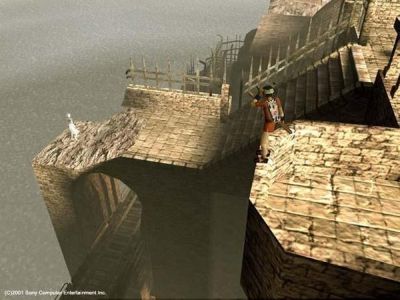
Ico came out for the Playstation2 in 2001 and it, and along with Shadow of
the Colssus has recently been re-released with a graphics upgrade for the
Playstation3. Ico is ultimately an adventure-puzzle game with a light mixture of
combat elements. The game is played from the perspective of Ico, a horned boy
who is imprisoned in a gargantuan tower. After freeing himself from his
immediate cell, he meets Yorda, a magic girl who unlocks the massive stone
doorways that block Ico’s escape from his jail.
The game play focuses on the difficulties of navigating the collapsing tower.
Ico can climb, jump, and fight. Yorda can open the doors, but otherwise must be
led by the hand through each level, and helped up walls. On top of that, if she
is abandoned for too long shadows creep up from the ground and try to make off
with her.
Since the puzzles themselves focus to heavily upon the environment of the game,
the tower is very lushly illustrated with hanging ropes, rotting wooden
buttresses, and bridges that stretch over blue watery coast. The player must
spend his time examining the space, moving through it, and puzzling over how the
space can be surmounted.
2. Shadow of the Colossus
This brilliant title by the same studio responsible for Ico is oft cited as
an excellent example of how video games could be elevated to an refined art
form.
Shadow of the Colossus takes the adventure game and simplifies it
down to one aspect: boss battles. The game plays through sixteen battles with
the hulking colossus – gargantuan roaming creatures who each present a unique
and puzzling challenge to overcome. Yet, to reach each of the colossus the
protagonist must first journey on horseback through an empty, expansive
wilderness. The land is covered in toppled ruins, lush forests, and flowing
steams. The colossus themselves are often gentle creatures and their deaths are
pathos laden affairs that hint at a less than virtuous conquest.
Like Ico, SotC is a puzzle game merged with the real-time over-the-shoulder
elements of the action-adventure genre. It’s elevated into the realm of
exploration by both its lavish detail to the landscape and it’s atmospheric
emphasis.
3. The Legend of Zelda, Link’s Awakening
I must sadly admit, I never completed Link to the Past and so I must put forth
Link’s Awakening as the best of the Legend of Zelda 2D iterations. The Link
to the Past is the definitive exploration game. The world begins first with
Link awakening on a small island where he is confined to a small space by
the necessity of finding the tools (sword, bow, shield, &c) that will open up
more of the island. The game is riddled with little mini-games, sidequests, and
clever level design that fits together like a massive puzzle.
Like Link to the Past and the original Zelda, Link’s Awakening plays from
an isometric perspective. Link runs about in real-time, and unlike the
traditional J-RPG, combat takes place in the over world through sword swings,
arrows, and shield blocks. The other item that makes Link’s Awakening stand
out over the J-RPG is the attention to detail. The realm is very lush, precisely
arranged with deep care. The action-adventure game play removes the elements of
grinding that have come to dominate the RPG genre.
4. Okami
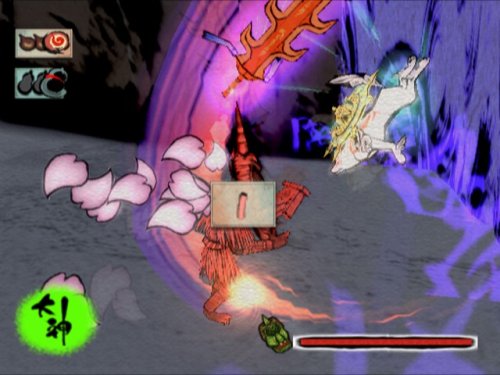
I saw Okami in 2004 at E3 and it was easily the best title on the show
floor. Okami builds on the action-adventure elements of Ocarina of Time
– 3D adventure title with real-time combat, item collection, clever dungeon
puzzles, big boss battles, and an amusing combat system. Then it adds some new
spices to the mix such as a creative Ukiyo-e look, J-RPG styled combat zones,
and a healthy heaping of traditional Japanese myth. This creates a game that in
every way embodies the idea of world exploration found in the Zelda series but
also sets it apart with a much more mature tone and unique setting that defines
Okami as a distinctive story-space from Zelda. It isn’t just aping
it’s predecessor’s gameplay, it is attempting to refine it into new form.
I started to dig through the
noitaminA
block of Anime from the last few quarters to see if anything got a good review
on ANN. I find that anything from noitaminA and gets a large volume of tens has
a tendency to live up to my expectations. What I stumbled upon was Ano Hi Mita
Hana no Namae o Bokutachi wa Mada Shiranai or We
Still Don’t Know the Name of the Flower We Saw That Day. I am perplexed by the
length of this title. I find Japanese titles often end up being oddly long
before domestic translators get a hold of them and chop them down to size. I
don’t even think we could turn this into a acronym AHMHNBMS?). I’ll call it
Ano Hana for now. Below consists of my initial impressions of the first
episode.
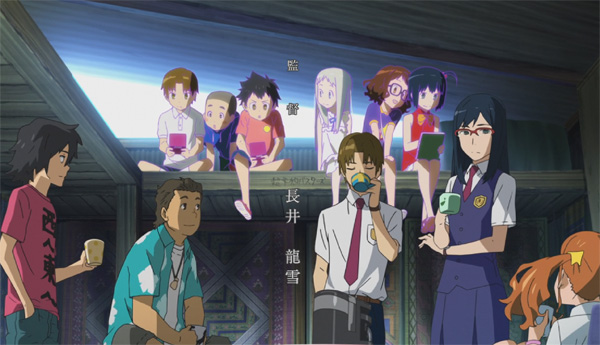
The production value of Ano Hana is, akin to most noitaminA productions: very
high. The backgrounds are rich and complex with a healthy mixture of colors. The
character designs are varied and animations rather well done. That said, my
initial impression is to be unimpressed with Ano Hana.
We get a fairly good outline of Ano Hana’s plot in the first episode. Menma
died in a childhood accident, her ghost returns to Jinta to ask for a wish to be
granted. The young ghost forgets the wish and instead tries to get the, now
older, Jinta back together with his childhood friends. Jinta, a shut-in, has
little interest in going out to socialize with his old friends who have drifted
apart becoming shallow and vain teenagers. This plot seems far too ripe with
pathos for the age of the cast. The flashbacks to their childhood, which is
really just a few year’s prior, held little power when I realized that the
characters still had a long, productive life ahead of them. At least Ebenezer
Scrooge was visited after a long, unproductive life when we can actually feel
sad for his having wasted it. Such makes the meager few years that Jinta and
company spend saddened by Menma’s demise paltry in comparison.
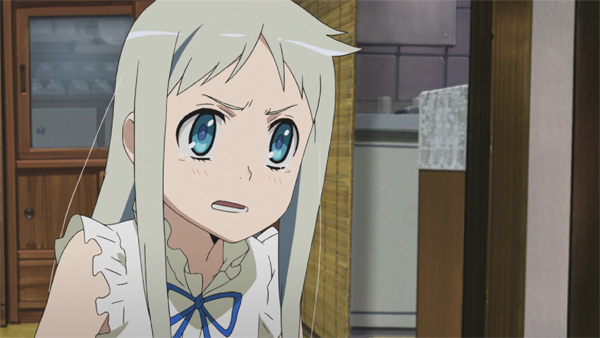
A large part of my dislike surrounds the character of Menma – a frail looking
stick of a girl who is definitely of the
Moe
character type. Her design is reminiscent of K-On! or Sora no Woto and
showcases a similar characterization to K-On!’s female cast. A full analysis
of why I do not particularly care for Moe would require more space than I
wish to go into right now. In simplest terms: I feel that reliance upon such
pre-built characters tends to generate a very shallow story, one that I have
seen before and have no interest in going through over and over again. Anaru,
Yukiatsu, and Tsuruko also seem like rather shallow characters, the caste is
only saved by my interest in the character of Poppo who appears at the very end
of the episode. Suddenly, I have a character who I might be able to relate to
and find interesting enough to continue through the entire series.
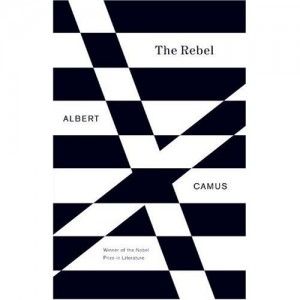
After several months of video game reviews, let’s take a look at something
entirely different, a text that is a rather appropriate capstone to the events
of 2011: Albert Camus’s The
Rebel.
In The Rebel, Camus examines
the history of the revolutions in Europe – starting with the French
Revolution in the late 18th
century which deposes the Divine Right of Kings, forever altering the role of
religion in the state and ultimately the faith of the cultural revolutions of
the dandy’s rebellion against Victorian society, the Marxist/Russian revolutions
of the 19th century and the culmination of these revolutions with the nihilism
expressed in Nazi Germany.
Through this examination of history, Camus examines the ethics of the rebel. He
establishes the causes of rebellion, why rebellion ultimately becomes violent
anarchy, and illuminates the reasons that we will most likely not see a return
of these rebellions in western society.
In reviewing the international news events of the last year, we can definitely
see this: uprisings in the Egpyt
spreading
over toLibya. Rioting over
austerity in Greece and Brittan calumniating in the OWS encampments in the
United Statesover similar issues. Yet, in the west the response has been much
more tempered than the violence in Libya. As Camus points out, the rioters in
the West, while displeased with the failure of the state are also very much
interdependent on the success of the state. They cannot simply tear down the
market system without tearing themselves down as they forfeit their livelihoods
and retirement benefits.
In light of these events, it is a good idea to sit down and examine the
successes and failures of past rebellions. Hence, Camus’ 1951 text is a very
timely, timeless text to pursue. Camus recognizes that a successful revolution
requires temperance by the rebel – a willingness to recognize that the state
has wronged them, but to not fall to criminality in response to the state. When
the rebel revokes limits and is willing to engage in the self-same murder that
he accuses the state, then he also revokes his own legitimacy. The limitless
rebel creates the various revolutionary disasters that we see inRussiaduring
Camus time, and in more contemporary times,Central America.
The Rebel is also an easier read than his earlier work, The Myth of
Sisyphus. The later work requires a much more complete understanding of
Existentialist philosophy (namely, Kierkegaard, Sartre, Nietzsche). Whereas,
The Rebel relies upon a much more common historic background that less
philosophically inclined readers are more likely to possess or could easily be
researched through a brief glimpse at Wikipedia’s entries on the French and
Russian Revolutions. A general understanding of Hegel’s concepts of history and
it’s importance to 19th century ideologies as well as a general overview of
Nietzche’s master/slave dialectic can help with the reading, but are not
necessary.
Last week’s reflections on
Okamiden upon the
game’s qualities resurfaced an old musing regarding games. I am very particular
about the games that engross me through thirty or sixty hours. Most games, by
some aspect of their design, fail to illicit such a strong emotional response.
What are the qualities of these games? What aspect of the design of say Super
Mario 64 illicits such a strong
response whereas Rachet & Clank brings out little to no response.
The feeling of playing Okamiden is different from playing Call of Duty. I am
an avid World at War player and can easily sink a hundred hours of multiplayer
game play over the course of a year. Yet, there is no resonance with Call of
Duty. There is frustration, truimph, and overall competition. I play such
games to build up a skill set and use it to triumph over other players.
Nevertheless, victory is fleeting. Like any sport, the match is reset, I play
again. Each round is unique with different opponents, different permutations of
strategy. It is fun to play such games, but they are not fulfilling. The need to
play is endless because each round brings on the next in an endless series that
never draws up into some telos.
Massive Multiplayer Roleplaying Games (MMORPGs) come in the same spirit as the
first person shooter, abet without the sense of competition. In the MMORPG, the
player begins the game and progresses up a ladder of levels, exploring new
spaces and expanding a repertoire. In this genre (World of Warcraft,
Eve:Online, Graal), I never got into the ‘end-game.’ The repetitiveness of the
game-worlds eventually drove me away, but not before I could explore the space
where these games take place. These titles are better, but still do not
capture the sensation I find in Okamiden.

The obvious answer is that Okamiden is a single player title, whereas Call
of Duty and World of Warcraft are multiplayer title. This is a correct
observation, I only bring up these multiplayer titles as examples of other
titles I actively play and to say that while they engross my attention they
never leave me wistfully recalling my experiences with the game.
What is different?
This question, I think is much larger than I first thought. Indeed, in answering
I think we ought to dispense first with the rather clumsy system of genres that
journalists and developers have hobbled together over the years. First-person
shooter, adventure game. platformer, puzzle game. These categories define
aspects of game rules whereas I am thinking about something much more ambiguous
since this element is found in both the earliest Mario platformer to the
puzzles of Ico and combat orientated of Muramasa. Certainly, it would not
hurt to transgress the history of games to see where first this element arises.
In the late seventies with the games like Adventure
and more importantlyZorkappear on the scene,. I wish to address
Zork since this title I do have experience with. Zork is an interactive
narrative. That is it. You read the paragraphs of text, pick out nouns such as
“mailbox,” or “rock” and then experiment with simple verbs such as “open,” “pick
up,” or “throw.” The game world exists on a sheet of scrape graphic paper or
only in the player’s mind if they have a memory for it. The text-based adventure
game eventually becomes the graphical adventure game with titles like Myst
where the player clicks about the screen. The gameplay of Myst is altogther
like that of Zork, but what once was a text parser is now represented through
icons.
How are these titles related to Okami and Zelda? They rely upon a narrative
to drive the game foreward. Gameplay exists as logical puzzles rather than
hand-eye-reflex coordination. Zelda is sometimes catalogued as an Action
Adventure title for this very reason. Nevertheless, so is Tomb Raider, Grand
Theft Auto, and God of War. Zelda shares very little in similarity to these
latter titles, indeed there is more ressonance between Zelda and Zork
then Zelda and GTA. Action Adventure is not a good definition for Zelda
because so often it is Action that is emphasized over Adventure in Action
Adventure titles.
The early Adventure games focused upon narrative since their entire world must
be expressed to the player through description and exposition. Zelda, like
Zork focuses on description and exposition particularly relating to the
exploration the space game takes place in. God of War, GTA, however, focus on
the action and in particular the actions of the protagonist. Moreover, there is
a larger aspect to the spatial arrangement of titles like Okami and Zelda.
Namely, that they present themselves as a kind of Zen Garden.
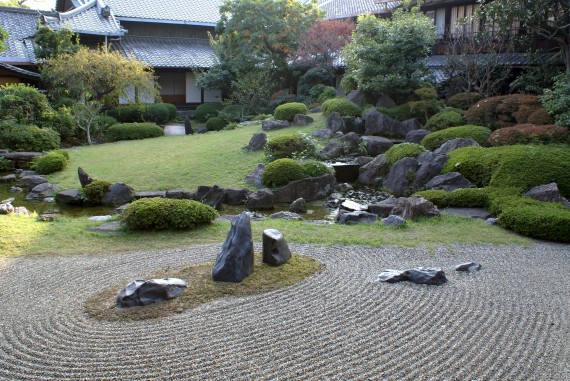
I need to find a copy of Andre Vestal’s The History Of Zelda or David Shaff’s
Game Over. The first, a gamespot article, seems to have disappeared and the
latter unavailable to me from the local library. I will have to resort then, to
wikipedia:
“The Legend of Zelda was principally inspired by Shigeru Miyamoto’s
explorations as a young boy in the hillsides surrounding his childhood home in
Sonobe, Japan where he ventured into forests with secluded lakes, caves, and
rural villages. According to Miyamoto, one of his most memorable experiences
was the discovery of a cave entrance in the middle of the woods. After some
hesitation, he apprehensively entered the cave, and explored its depths with
the aid of a lantern. Miyamoto has referred to the creation of the Zelda games
as an attempt to bring to life a “miniature garden” for players to play with
in each game of the series.”
(Wikipedia)
The Legend of Zelda is precisely this, a recreation of the natural world or a
“pocket garden” as other Miyamoto interviews put it. This garden aspect makes
the childhood encounter with nature a centrifugal aspect of the gameplay. The
arrangement of the levels intended to create the miniature abstraction of
landscapes found in the zen rock garden. The closer then that a level design
adheres to this idea the greater the calming and exploratory aspect the game
takes on. Thus we see this aesthetic in the Japanese titles of Okami, Zelda,
Mario, Ico, and Shadows of Colossus. We see this less often in the western
designs, but rather get God of War and GTA – action driven versus
reflective-driven titles. Nevertheless, western developers do approximate this
effect in titles like Elder Scrolls, Myst, or Banjo & Kazooie (in fact,
I could argue that no platforming title can have good level design without some
stumbling upon these principles).
I would call this category the Zen Garden or Exploration Game and I see
these titles as the aesthetic pinnacle of game design.
I suppose it’s not really news that the 2011 Christmas season for game releases
is somewhat excellent this year around. Studios always seem to hold out on their
big-budget titles until around this time of the year, so let’s examine my top
five picks for this year:
I played Elder Scrolls Oblivion back when it first came out. The graphics Skyrim’s
predecessor blew me away and I spend countless hours wandering about the
countryside in search of herbs. Unfortunately, collecting herbs and perfecting
non-combat skills in Oblivion just got you killed as your opponents would all
level up to match you’re supposed new combat prowess. Later mods for the game
would resolve a lot of the launch issues, transforming it into a much more
enjoyable experience. For this reason, I’m sticking away from Skyrim until the
mod community has had a swing at it. That said, the graphics and in-game footage
that I have seen so far blows me away.
I have yet to pick up a 3DS, and I most likely will not be picking one up
anytime soon on account of the plethora of unopened DS titles on my shelf.
Handhelds have always been in my sweet spot for games, and a lot of experimental
titles seem to hit handhelds – and thus by wallet. If I had a 3DS, I would most
likely be picking up Super Mario Land 3D. The previews that I have seen so
far make the game out to be the successor of Super Mario 64. Anything that
gets us more of the traditional Mario experience and away from Miyamoto’s more
experimentive (Mario Sunshine?) titles would be good in my book.
2. Mario Kart 3DS
Maybe I ought to get a 3DS, there seems to be a lot of items on my list that are
coming out for it. I’ve played the Mario Kart series all the way back to the
SNES and I have found every iteration of the formula to be refreshing and
extremely fun.
You should’ve seen this one coming. I am extremely excited about Skyward
Sword. Accounts from friends say that it is reminiscent of Ocarina of Time
and with a story of equal measure. In particular, I am excited for the first
Zelda title that was designed for the Wii hardware.
A quick post to point out that there is a new
article, examining my
early impressions of Okamiden, over at The Wind-Up Culture
Blog. I actually have new material lined up for the
next few weeks on the blog, and I plan on making it a point to update the site
at least once a week with new material throughout the winter.
Drifting in the Sea is still on hiatus. I am not sure if I
want to continue the current plotline, or devote what little time I have into
working my comic adaptation of the Saga of the
Volsungs, and complete
the series of Weird short stories
that I began last year on my road trip across the southwest.
In other news, many of my first sites at Gage E-Services will start to roll out
over the next few weeks. I have a lot of work done adding modules, and fixing
items on existing client sites – but these will be projects that I worked on
from the early design stages up through completion. I am very excited about
this.

I am six hours into Okamiden
right now or roughly a quarter of the way through the game. Considering Okami
is one of my favorite games for the PS2,
Okamiden as a sequel has some very big shoes to fill. My initial impression of
the game was just how similar Okamiden is to it’s big brother. It replicates
many of the game environments from its predecessor, the brush-manipulating
game-play techniques, and graphical styles. Yet, it does this in a very paired
down system and it can be difficult to judge Okamiden harshly because it’s
landscapes are more restrictive, combat less frantic, or content less grandiose.
After a few hours, the comparisons drift aside and I can enjoy Okamiden for
what it is – a very fun adventure title that captures all of the witty plots,
beautiful scenery, clever puzzles, and elaborate art of it’s predecessor. I am
even glad to see such a faithful recreation of Okami’s setting since returning
to Shinshu fields and Kamiki village brings back a very fond memories of the
other games. I get a great deal of delight in reconnecting with the characters
of Mr. Orange, Susano and Issun – much like meeting friends whom you haven’t
seen for a long while over for lunch. In many ways, this gives_ Okamiden_ the
feel of an after-story, or a kind of prologue to the events of Okami in which
the protagonist revisits the places where he has been in a kind of
mini-adventure, such as when Frodo returns to Hobbiton in The Lord of the
Rings.
The plot generally follows that of Okami: great evil sweeps over the land,
demons abound and the wolf-god Chibiterasu, the descendent of Akamatsu
(Okami’s protagonist) must go about the world cleansing it of the presence of
demons and restoring the land to health so that the cherry blossoms and bloom
again. The strength of the plot is that it keeps pulling you back to old
characters and developing them throughout the game rather than pushing the
protagonist out into a world of generic cardboard characters and endless scenery
changes. I expect to return to the village of Kamiki and Yakushi time and again
throughout the game as I chase over old hunting grounds on new quests. This
sense of place found in the Okami series captures the spirit of Ocarina of
Time better than any of the Zelda titles that attempt to homage that N64
title.
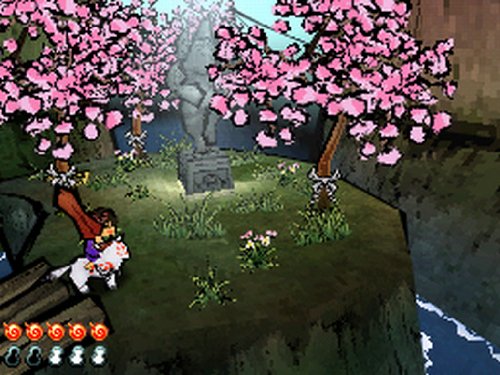
The aesthetic experience of Okamiden recalls the Edo-period wood-block prints
of Japan with tapered outlines and a very warm solid palette of colors. However,
recreating the style of Okami on the DS’s limited hardware causes some issues.
Frame-rates for character animations seem rather low giving Chibiterasu a bit of
a jumpy walk and causing combat to be disorientating. The maps are also cut into
very limited spaces requiring load times when stepping from one space to the
next and interactive objects only loading into view once Chibi is nearly
standing upon them. Okamiden could have taken a note from the old Super Mario
64 title which has much more seamless loading transitions.
Despite these fallbacks, I would say that Okamiden is beating out all of the
DS Zelda titles for the crown of “best” DS Adventure game. I am looking
forward to playing through it to the end and getting back with a final report.
Most of my favorite web comics are ones that I discover near the end of their
runs. Michael Poe’s Exploitation Now!, Josh
Phillip’s Avalon, or It’s
Walky – I stumbled upon these near the end of their
runs where I could sit down and spend several days reading through the archives.
This last month, I embarked upon reading through the archives of two of my
favorite web cartoonists: Michael Poe and Fred Gallagher.
The experience of reading through an archive is vastly different from following
along as the comic is created. Often in the daily wait between new pages months
or even years can go by between the appearance of minor characters and
stretching long, convoluted plots out over months can cause many of the subtle
details to be lost.
I prefer to read the archives online. I do buy the print editions to help the
artists, but I find that one of the great aspects of web comics is that
necessary beat – a brief “ah” while you wait for the next page to load. This
gives me a moment to reflect upon the events of that page, to get caught up on
the cliff hanger, and appreciate the art. A printed book is too easy to skip
ahead, the pages fly by in a blaze. I try to remember to give that beat with a
print comic and pause before I turn the page. Nevertheless, print artists fail
to fully utilize that beat as effectively as web cartoonists.
Michael Poe’s Exploitation Now! was my introduction to web comics. I loved
watching how the art and characters progressed from sketchy, one-dimensional
creations into a complex fleshed out world. I am also rather impressed with
Poe’s dark sense of humor that seems to fixate at times upon the more disgusting
aspects of bodily existence. Poe’s more recent work, Errant
Story, I liked not as much. In rereading the work from
the beginning, I begin to understand why. In following the story the first time,
I became confused by the complex place names and history. I became lost. In
rereading the work, I caught all the history, all the characters and found
myself actually enjoying the work just as much as Exploitation Now!.
Fred Gallagher’s Megatokyo, I began reading in 2004 and
since then it has added nearly a thousand new pages. In all the mess of filler
art days, guest strips, and hiatuses I became rather lost in the main storyline.
Following it through a second time, I see why I enjoyed the work. Though it’s a
long story and at present, I am only up to 2002.
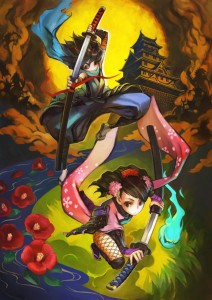
Continuing the sword-collecting series, I take a look at Muramasa for the
Nintendo Wii. Before I begin, let me get it out of the way. I am a big fan of
Vanillaware’s previous title, Odin Sphere, and the overall design philosophy
of revisiting the game design challenges of two-dimensional design. It was a sad
day when developers jumped ship for three-dimensional graphics, and I find it
nice that there are still a few developers out there who, like me, would rather
see the processing power of our new consoles put to envisioning the advances of
the older two-dimensional genres.
In the case of Muramasa the current-generation variation of the side-scrolling
action games revisits the action of the arcade days of yore. With the new
technology however, comes an even faster-paced gameplay as dozens of enemies
swarm across the screen swinging swords, throwing ninja stars, and battling the
player. All of this is mixed together with a RPG-styled leveling system that
encourages item collection.
My first impression of Muramasa is the sheer depth of the artwork which
unravels like a fine painting. The orchestrated music fits perfectly with the
gameplay enhancing the appreciation of the game’s atmosphere which drips from
the screen into my eyes. Odin Sphere focused on variety by telling the tales
of different characters each with unique fighting styles. The result was a bit
rough. Some character’s combat systems were rock solid, others felt hacked
together. Muramasa solves this by focusing on just two characters at their
Obarahu style combat. The result? A very well polished combat system that is a
thrill to play.
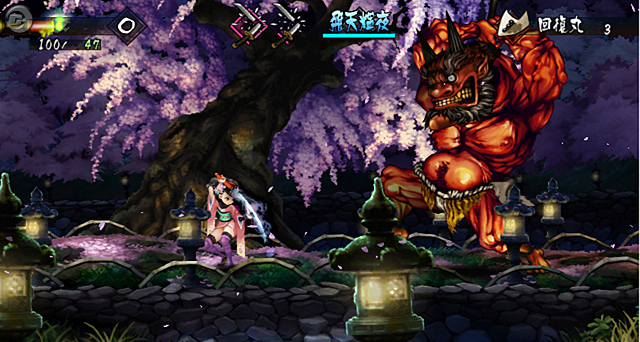
Not everything is good in Muramasa. Some of Odin Sphere’s mechanics were
sadly cut. Planting fruit to grow new items, a mechanic I loved, is now gone; an
unbalanced difficulty system gives you the choice of slicing through enemies
like butter, moderate strategy, and insanely difficult; platform jumping is
difficult to predict due to an unclear collision detection beneath the
hand-drawn character sprite; and the battles can get tedious if played for a
long sitting. Nevertheless, I would say Muramasa is the best third party Wii
title out there – even though it makes no use of any Wii-specify hardware.
Following Super Mario Galaxy and Tokyo Magnitude 8.0, I began
Katanagatari
and Muramasa – a show about
collecting swords and a game about collecting swords! Similar plots match
similar settings, as both series are set in the early Genroku period shortly
after the shogun unite the warring kingdoms of Japan. This week, I’ll take a
look at Katanagatari.
In Katanagatari the protagonists, Togame the “Strategian” convinces Shichika,
a swordsman (more like a marital artist) to help her collect twelve deviant
blades of Shikizaki – whose power is fabled to grant dominion over the world if
collected together. Together they travel Japan in an episodic battle-of-the-week
format challenging ninja, swordsmen, and pirates to duals over these fabled
swords.
I tend to avoid fighting animes because of the tendency for fight to dominate
the episode. After all, if an episode has 25 minutes to both tell a story and
showcase an epic battle, than the story tends to become little more than an
excuse for fighting. Katanagatari escapes this flaw through it’s 50 minute
episode length. With all this extra time, Katanagatari’s conversations can
reach Bakemonogatari-lengths. This gives the work a much more
feature-film-like pacing as we get to know the characters through long
conversations over meals, bathing, and other breaks that typically won’t make it
into the frantic pace of shorter animes.
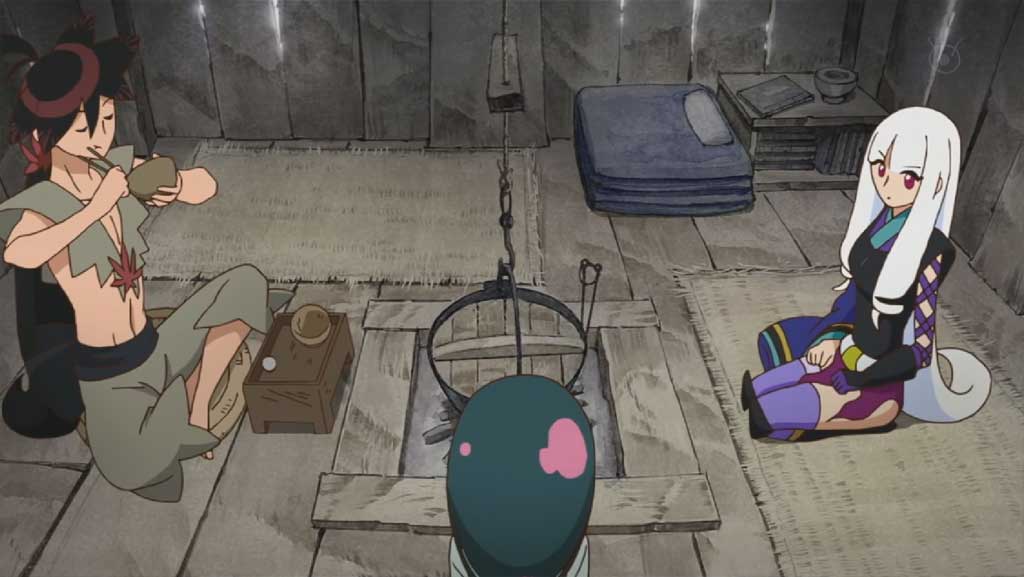
White Fox, a relatively new studio
showcases some amazing production values in the animation. Katanagatari’s
character designs are unique and take some time to accept. This design focuses
on simple characters with few, yet bold, lines and unornamented eyes that
harkens back to the character designs of Osamu Tezuka. It is still common to
see such designs in a lot of manga, nevertheless the interpretation of manga
into animes often results in a bit of more (often unnecessary) flourish.
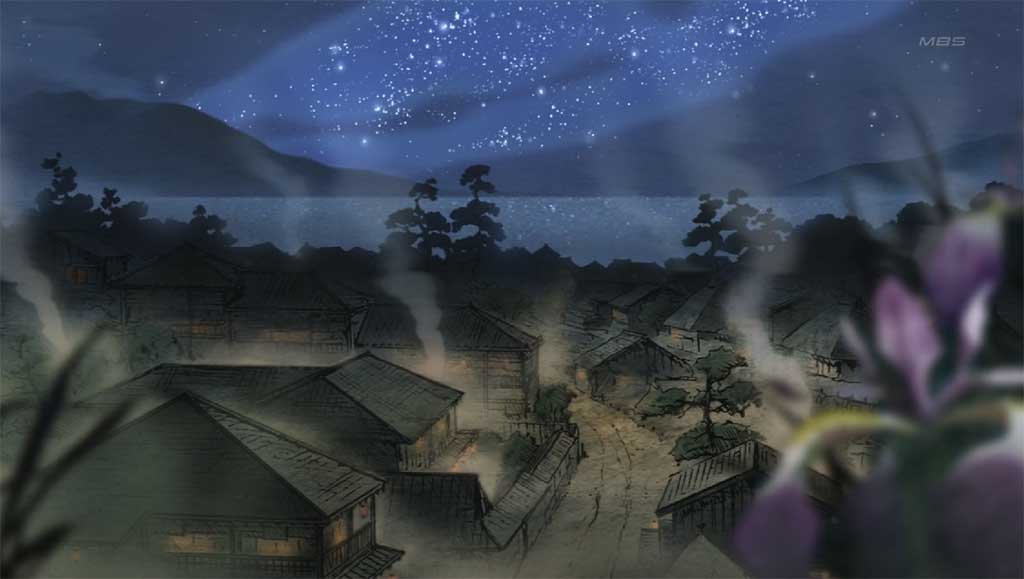
The backgrounds are a mixed bag. Some scenes portray sprawling countryside with
a very traditional feel as though each is a water-colored painting – a similar
style to those we might expect in Mushishi or a studio Ghibli film. Yet, once
in the scenes_ Katanagatari_ quickly lose this detail for a much flatter
computer-painted appearance.
At four episodes in, I find that Katanagatari has hooked me right into the
adventure. I can see why ANN rates this series so highly and I find myself
surprised that I held out on watching it for so long. I would encourage anyone
who is looking for a good light-hearted action anime to give this a look. It’s
short, enjoyable, well drawn, well plotted, and contains some very fun
characters that (so far).
I follow roughly thirty webcomics on a daily basis. I say roughly because this
number tends to change a lot. I cull the collection about once a year to remove
comics on hiatus and comics that I grew bored with. Yet, this is counterbalanced
by binging on new webcomics. Once and a while, I’ll just start clicking on ads
for new comics, dig through the links on my favorite comics and discover (or
re-discover) new series to read. There are a few criteria that I look for in a
new comic to follow:
- An archive! I want to know that this comic has staying power, that the
artist is committed to delivering on a regular basis and won’t get bored in
a month and stop posting. Generally, I like to see about a year of regular
updates in the archive or at least fifty pages of comics.
- Coherence. Some strips are gag-a-day strips, some artists tell long epics –
whatever the strip decides to do, I want to see some coherence to it. An
incoherent comic tends to end up a sketch blog.
- They need to be good! Comics are about getting a laugh, or telling a story.
If the piece just doesn’t communicate to me, than I’ll pass.
This last week I had a cold, which gave me an excellent excuse to do nothing but
binge on some new comics! My findings this time included a few oldies and one
newer comic:
SMBC – This one has been around for a while. I
tend to stumble across it once a month, read a bunch of random comics, laugh at
it, and then forget about it. SMBC is a gag strip akin to
XKCD or the Farside. SMBC’s following is a lot like
XKCD’s following in so far as if you have a lot of geeky friends, they will
send you these strips on a regular basis. The writing is amazing. As I poured
through the archives I found myself laughing harder than I have in a long while.
Girl Genius – I stumble on Girl
Genius at least once a year. It’s a hard series to get into. I started on the
archive dozens of times, but once I realize that there’s nearly ten years of
pages to read, I quit. I don’t quit because I hate Girl Genius, I quit because
I love Girl Genius, It’s an amazing story with gorgeous detailed artwork that
has layers upon layers of little visual jokes worked into an outpouring of
details (how they succeed at doing three pages a week, I will never know). The
result is an extraordinarily visually dense work that requires slow, careful
reading to fully appreciate each page. This time I surmounted the challenge of
reading through the first year’s worth of pages. After that, I was too hooked to
stop. The plot starts off slow, but keeps ratcheting up the tension with each
page until the entire story becomes a non-stop rollercoaster.
Living with Insanity – With only two
years in it’s archive, this is a new one that I stumbled across. LwI is
another ‘bizarre-slice of life’ series trying to be like Queen of Wands or
Questionable Content. The illustration is decent but lacks distinction from
other generic computer-aided illustrations. The plotting feels like it’s just
stumbling along. The story arcs in the series tend to peter out halfway through,
and the humor lacks the polish of the longer running series whose footsteps
LwI is following. LwI tries to make up for this with the tactics perfected by
Michael Poe – gratuitous sex, nudity, and fan
service. I’m going to follow it, but it will probably not last the next culling.
I started watching Tokyo Magnitude 8.0 just a
few days before the quake hit Japan last month. For those who don’t know, Tokyo
Magnitude 8.0 depicts the aftermath of an 8.0 magnitude earthquake centered on
Tokyo. The creators of the show set out to deliberately create an accurate
account of what such an event would be like that is, no over-the-top anime
hijinks, no racy sexuality, no big-time explosions, none of the more fantastical
elements we expect from anime.
I must admit, I am not a fan of realism, and with it’s strong emphasis on
realism, Tokyo Magnitude suffers the problems I find with most of the
realists: reality simply doesn’t have the same sense of narrative rise and fall
and real people tend to have problems that, all and all, are rather boring. The
result is rather undramatic narrative that feels like a school-room educational
video. There is an earthquake (tense, exciting) and then the protagonists walk
home (dull).

The animation of Tokyo Magnitude is rather superb, which is what I’ve come to
expect from the Noitamina block.
Indeed, I must admit my initial attraction to the show stems from the title
cards for the series: each card depicts the city of Tokyo in a state of ruins. I
wish I knew the artist responsible for the works as they remain some of my
favorite cityscape pieces.
Yet, the series fails to live up to the artwork, which is really a
disappointment considering the sheer talent (Studio Bones, e.g.* Darker than
Black and Full Metal Alchemist*) responsible for the show’s execution. The
story pacing feels like a short OVA drawn too thin over it’s eleven episodes. A
tighter plot condensing the story into three episodes would have improved the
narration, particularly since so few memorable events occur in middle of the
series. Nonetheless, elven episodes it is.
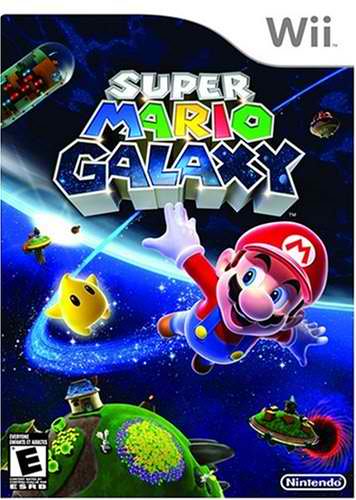
Having done Zelda and now Mario, I think I might end up with a long run of
Nintendo-game-related articles.
Super Mario Galaxy was one of the launch titles for the Nintendo Wii back in
2006 when the system was still nigh impossible to find on store shelves. Wait a
few years and it becomes surprisingly easy to find, however, not cheaper. Unlike
Sony, who tends to drop their best-selling title prices soon after launch,
Nintendo keeps prices high and even today a copy of Mario Galaxy runs for $40.54
on Amazon, a mere $6.37 cheaper than it’s recently released sequel. Writing a
review of such an old game on a gaming-blog is probably preaching to the choir.
Get used to it, I plan on writing many more articles about even older hit
titles.
First Impression
Super Mario Galaxy contains the same amount of plot expoltation as the original
Super Mario for the NES: a hair-thin plot of a giant turtle kidnapping a
princess, and the red-suited man who goes to save her. Mario is and never was
much for plots, nor should it be! Mario is all about giving someone an excuse to
explore the imaginative spaces of level designers. The collecting of coins,
stars, and defeating of bosses are just a thin glossing to give gamers
incentives to pick around through each of the game’s many “galaxies.” Because of
this, Super Mario Galaxy realizes, much better than Super Mario Sunshine, the
game-play that made Super Mario 64 so compelling to play through and complete.
To get an idea of Super Mario Galaxy’s gameplay simply imagine Super Mario 64,
but wrap each stage into a sphere with its own gravitational pull. Mario leaps,
bounces, and flies between these spheres landing on one or another and often
running up walls. Intermixed amongst this is more traditional levels in which
gravity is clearly down and leaping off the edge causes death.The opening stage
expresses the creative potential of the game and the gravity-bending aspects
will contribute to future stages as they produce increasingly surrealistic
playgrounds for exploration.
At this point in the game my only complaint is against the musical score and
progression. The tempo, much faster than earlier Mario games, tended to
discourage idle exploration in the earlier stages. I felt rushed to run through
each level, grab the star and move on to the next level. Perhaps because of this
fast tempo, the rewards in the early stages come too quickly. I collected many
of the stars necessary to unlock the advanced stages in just a few hours, and
(to my surprise) was able to beat the game with only 60 of the 120 stars in the
game. Thus, I beat Koopa long before I even had a taste of the game’s true
potential. I can imagine that this quick progression is because of the title’s
launch status. If Nintendo intended this game to attract new gamers than a
difficult learning curve might put them off from future game purchases.
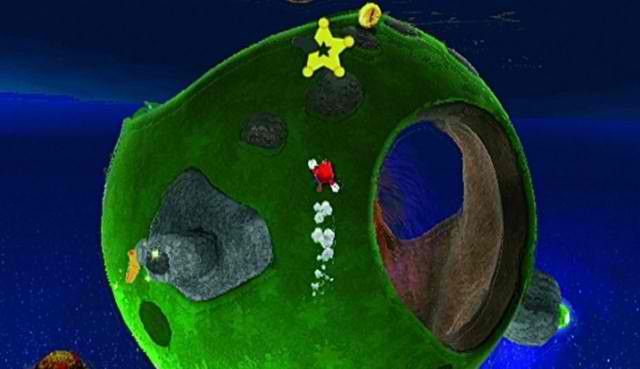
The Mid-game
Super Mario Galaxy wins back whatever scorn I might put upon it in the latter
half of the game. After beating Koopa, all new coin-collecting stages appear
which encourages a much more methodical approach to the galaxies. The pacing
also slows in later galaxies and the time spent completing puzzles in a level to
advance and collect each star lengthens as the levels progressively get larger
and more complex. The result is that the more experienced gamer who progresses
on to collect all 120 stars is rewarded with a much more engaging game even
while the new-comer can collect the reward of “winning” early on. Secret stars
compound this by sending Mario back to old galaxies looking for alternative
routes to completing each stage, and “prankster” comets mix up the levels by
adding extra difficulty through time-limits, faster enemies, ghost-races, and
on-hit-kills health.
Conclusion
It took me 20 – 30 hours of play to collect all 120 stars in Super Mario Galaxy,
which puts it on par with the length of most contemporary games. As an
introduction to the Nintendo Wii, I think Super Mario Galaxy makes a great game
and one that I think Nintendo hoped would demonstrate the possibilities of
reinvisioning older game genres with their new control scheme. It is a pity that
Wii Sports became the real champion of the system rather than Super Mario
Galaxy, as there is a glut of mini-game Wii titles, and very few platformers of
Super Mario Galaxy’s caliber.

As I grow older, I increasingly become one of those gamers who spends a great
deal of time reading about the hobby rather than doing it. In-between becoming a
curmudgeon who complains about how they just don’t make games like they used to,
I find a few games that still capture my attention. Zelda: Spirit Tracks would
be one such game.
I would love to speak fondly of how Spirit Tracks embodies the wide open
spaces of Ocarina, or how the interlocking and complex dungeons rivaled the
masterful level design of Link’s Awakening.
Unfortunately, I cannot. The curmudgeon must come out and point out how Spirit
Tracks is quite literally a game on rails. The vast sweeping steppes of Hyrule
which opened up for exploration in Ocarina are no more. This new system,
pioneered in the previous DS title restricts Zelda’s classical theme of
exploration into a mindless grind of watching scenery fly by a train’s window.
I ought to write at great length about the more Zen aspects of Zelda, how the
wandering about the luscious natural settings of an adventure game mimics the
experience of a Japanese rock garden. I might point out that Miyamoto once said
that he hoped that the Mario and Zelda games would elicit such an aesthetic.
Nonetheless, such would be for a much longer, and vastly more academic piece. I
would say that Spirit Tracks retains only a shadow of these traits. Once outside
of the train, there are places to walk about, but they lack real defining
character and were too small to allow me to poke around and really explore the
space.
Spirit Tracks is easy. This should come as no surprise as Zelda titles started
sliding into the easier realm some time ago. For the old-school gamer (or the
hardcore masochist) who enjoys a good round of nigh-impossible
difficulty, Spirit Tracks will disappoint. Nevertheless, for those whose
skills have atrophied from the demands of “adult life,” Spirit Tracks fits the
mold of a good casual distraction.
The one saving grace for Spirit Tracks is its pacing. The dungeons are small,
but this has the benefit of dividing the game into bit-sized chunks. Plowing
through a dungeon in an hour was standard. For a short-on-time gamer, this made
playing through Spirit Tracks a very enjoyable experience. It may not possess
the grace of the earlier Zelda titles, but at least it is a small bone to us
adventure gamers.





 I
came upon the film Sunshine by way of the exemplar Moon. The latter being
perhaps one of the best instances of hard science fiction that we have seen in
theatres since 2001 A Space Odyssey. Sunshine, while a very good film, cannot
live up to Moon simply because of some very basic plotting issues. Nevertheless,
it is a very interesting science fiction flick.
I
came upon the film Sunshine by way of the exemplar Moon. The latter being
perhaps one of the best instances of hard science fiction that we have seen in
theatres since 2001 A Space Odyssey. Sunshine, while a very good film, cannot
live up to Moon simply because of some very basic plotting issues. Nevertheless,
it is a very interesting science fiction flick.

























